The University of Hong Kong Division of Landscape Architecture Annual 2020-21 香港大學
二〇二〇 | 二一
園境建築學部設計年鑑

BA(LS) field trip to Jubilee Battery
目錄
Contents 4
Table of
Introduction Master of Landscape Architecture Postgraduate Diploma in Landscape Architecture Master of Landscape Architecture Program ........................................................................................... 14 Landscape Design Studio I .......................................................................................................................... 44 Annual 2020-2021 Introduction ................................................................................................................... 12 Landscape Thesis ........................................................................................................................................... 28 Foundation Design Studio I ......................................................................................................................... 98 Foundation Design Studio II ....................................................................................................................... 102 Histories of Landscapes............................................................................................................................... 106 Landscape Systems....................................................................................................................................... 108 Landscape Technologies and Techniques.............................................................................................. 110 Environment and Communities of the City ............................................................................................. 112 Landscape Media I ......................................................................................................................................... 114 Landscape Media II ........................................................................................................................................ 116 Landscape Architecture Intensive ............................................................................................................. 118 Postgraduate Diploma in Landscape Architecture Program .............................................................. 18 Landscape Design Studio II ......................................................................................................................... 48 Bachelor of Arts in Landscape Studies Program ................................................................................... 22 Landscape Design Studio IIIB ..................................................................................................................... 56 Landscape Technology I .............................................................................................................................. 64 Landscape Technology II ............................................................................................................................. 66 Landscape Plants and Ecology I................................................................................................................. 68 Landscape Media I ......................................................................................................................................... 70 Landscape History and Theory I .................................................................................................................72 Landscape History and Theory II ................................................................................................................74 Landscape Architecture Practice ................................................................................................................76 Elective : Urban Arboriculture ..................................................................................................................... 78 Elective : Advanced Topics in Sustainability ........................................................................................... 80 Elective : Advanced Topics in Landscape Architecture Theory ........................................................ 84 Elective : Advanced Topics in Urbanism .................................................................................................. 82 Elective : Advanced Topics in Landscape and Urban Research Methods .................................... 86 Elective : Horticulture and Design ............................................................................................................. 88 Thesis Preparation .......................................................................................................................................... 90 MLA Prerequisite ............................................................................................................................................. 92 Bachelor of Arts in Landscape Studies Common Core Curriculum MPhil/ PhD .................................................................................................................................... 190 Staff List ........................................................................................................................................... 198 Landscape Design Studio V ....................................................................................................................... 124 Design on the Future : Sustainability of the Built Environment ........................................................ 180 The City : Histories of Urbanism and the Built Environment ............................................................. 182 24 Frames : Communicating Ideas through Film .................................................................................. 184 Nature in the City : Beyond the Concrete Jungle ................................................................................. 186 Landscape Design Studio IA ...................................................................................................................... 130 Landscape Design Studio IB ....................................................................................................................... 134 Landscape Design Studio II (2019 Cohort) ............................................................................................. 138 Landscape Design Studio II (2018 Cohort) ............................................................................................. 142 Landscape Design Studio III ....................................................................................................................... 146 Landscape Design Studio IV ...................................................................................................................... 150 Technology in Landscape Architecture .................................................................................................. 154 Plants and Planting Design I ....................................................................................................................... 156 Ecology and Sustainability .......................................................................................................................... 158 Landscape Design in China ........................................................................................................................ 160 Introduction to Landscapes ....................................................................................................................... 162 Landscape Representation I ....................................................................................................................... 164 Landscape Representation II ..................................................................................................................... 166 Landscape Representation IV .................................................................................................................... 168 Faculty Interdisciplinary Course - Get Inspired! ................................................................................... 170 Faculty Interdisciplinary Course - Reaching Out .................................................................................. 172 Landscape Design Studio IIIA ..................................................................................................................... 52 Landscape Design Studio IIIC ..................................................................................................................... 60 6 7 The University of Hong Kong Division of Landscape Architecture Annual 2020-21 香港大學園境建築學部設計年鑑 2020-21

MLA field trip to Lei Yue Mun
簡介 10
Introduction
Mathew Pryor Head Division of Landscape Architecture The University of Hong Kong
DLA 2020-21 Yearbook, again presents the very best student work from the landscape design studios and technical courses of the four-year Bachelor of Arts in Landscape Studies (BA(LS)), the two-year Master of Landscape Architecture (MLA), and Postgraduate Diploma in Landscape Architecture (PDLA) programs. The move to online teaching since due to the pandemic posed numerous logistical and communication challenges for students and teachers, but the positive response from all members of the landscape community and the way in which we have been able to take advantage of new approaches and technologies to complete their coursework has been especially heartening.
The severe social and environmental challenges faced by countries in Southeast Asia, resulting from rapid increases in population, urbanization, resource depletion, climate change, waste and pollution, technological advances, etc., provide the technical challenges and intellectual questions within which our students develop the landscape architectural knowledge, skills and attitudes that will enable them to lead the effort in addressing these issues. Complexities of built and natural environments are explored through multidisciplinary approaches and across a range of scales. Proposals for strategic landscape policy and planning, and specific design, action and management interventions, are made relevant to both the environment and community within which they are set, through dialog, research, design and performance evaluation. Students engage with these challenges both in the classroom and through extensive local and international field trips and numerous encounters with community groups, NGOs, governmental agencies and industry experts. Despite the travel restrictions in the spring semester, students were still able to travel to urban and rural areas of many destinations in countries within the region.
The Division has continued to expand its research activities, and landscape colleagues have pursued diverse research studies on landscape, health, heritage, community and environmental issues, in conjunction with many of the Faculty of Architecture’s and University research centers including the Virtual Laboratory of Urban Environments & Human Health; the Belt and Road Observatory; Healthy High Density Cities Lab; Urban Ecologies Design Lab; and the Architecture, Urbanism, and the Humanities Initiative.
彭文輝 香港大學 園境建築學部主任
園境建築學部年鑑,再次展示了四年制園境學文學士、兩年制園境 建築碩士和園境深造文憑的園境設計工作室和技術課程中最優秀的 學生作品。因疫情關係而轉向網上教學,為學生和教師帶來了許多 後勤和溝通上的挑戰。然而,園境課程所有成員反應積極,我們亦 能夠善用新的學習方法和技術來完成課程,都令我們感到高興。
人口迅速增長、都市化、資源枯竭、氣候變化、廢物污染和科技進 步等導致了東南亞許多國家面臨著長期且嚴峻的社會與環境挑戰, 這都為我們的學生提供了技術挑戰和知識問題。同學透過發展園境 建築方面的知識、技能和態度,使他們未來能致力領導解決這些問 題。運用跨學科的方法和不同的尺度去探索建築和自然環境的複雜 性,從策略性的景觀政策和規劃提案到具體的設計、行動和管理干 預措施,都與其所處的環境及社區背景相關,都須經過討論、研究 、設計和績效評估得以確定。學生在課堂上以及透過廣泛的本地和 國際實地考察、與社區團體、非政府組織、政府機構及行業專家的 持續接觸應對這些挑戰。儘管春季學期出行受到限制,同學們仍然 能夠到訪區內不少國家裡之城市和農村地區。
本學部繼續擴大其研究活動,學部同事與建築學院及大學的多個研 究中心,包括城市環境與人類健康虛擬實驗室、「一帶一路」觀察站 、健康高密度城市研究室、城市生態設計實驗室以及建築學、城市 學、人文科學創新計劃,對景觀、健康、歷史建築、社區及環境方 面的眾多議題繼續展開廣泛研究。
The University of Hong Kong Division of Landscape Architecture Annual 2020-21 12 13 香港大學園境建築學部設計年鑑 2020-21
Master in Landscape Architecture (MLA)
The Master of Landscape Architecture (MLA) is a two-year postgraduate degree in landscape architecture accredited by the Hong Kong Institute of Landscape Architects. Our program is distinguished by a commitment to teaching landscape architecture as an interdisciplinary field of study in which core competencies of landscape architecture are examined alongside developments in planning, conservation, urbanism and ecology.
The MLA curriculum is structured around engaging the critical social, economic and environmental issues shaping Southeast Asia and the greater Pearl River Delta today. Within this context, our approach to landscape architecture is one that spans from the urban to the rural, in which issues of density and development necessitate novel social and ecological solutions. By utilizing problem-based approaches to learning and by emphasizing critical, research-informed design practices, we prepare our students to take leadership roles as scholars, teachers, and practitioners.
The MLA courses are organized into themed tracks which include design studio, history & theory, technology, and media. Foundation studios explore landscape systems, urban ecology and the formal and informal dimensions of the public realm. One of the two core studios takes students to regions in Southeast Asia in order to carry out fieldwork and engage with local communities in places where landscape issues intersect with rapid development and urbanization. Final-year studios explore themes of landscape infrastructure, urban design, and environmental planning. The MLA education culminates in an independent thesis project in which students articulate a critical position within the discipline of landscape architecture and test the proposition through a design and research process.
園境碩士課程 (MLA)
娜塔莉· 埃切韋里 高級講師 園境碩士課程及 園境深造文憑課程 統籌主任
園境碩士學位課程為期兩年,得到香港園境師學會的認證。我們的 課程以致力將景觀建築學作為一個跨學科的研究領域而著稱,密切 關注當下城市規劃、保護、城市化和生態學的發展來檢視學科的核 心競爭力。
園境碩士課程圍繞影響當今東南亞和大珠江三角洲地區的重要社會 、經濟和環境問題。在這種背景下,我們的園境設計教學涵蓋從城 市到農村的各種場景,其中密度和發展問題需要新的社會和生態解 決方案。我們採用以問題為本的學習方法,強調批判性和基於研究 的設計實踐,培養學生在研究、教學和實踐方面擔當領導角色。
課程根據主題進行安排,包括設計課、歷史和理論、技術工藝以及 設計媒體。基礎設計課探索景觀系統,城市生態以及公共領域的正 式和非正式維度。另一個核心設計課將學生帶到東南亞地區進行實 地考察並與當地社區建立聯繫,這些地區的景觀問題常與快速發展 和城市化相互影響。第三學期的設計課將探討景觀基礎設施,城市 設計和環境規劃等主題。課程結束前,學生需要在最後一個學期獨 立完成一項綜合設計與研究的畢業設計。在這個項目中,學生要清 晰闡述自己在該學科的批判性立場並通過設計和研究進行檢驗。
ECHEVERRI Natalia Senior Lecturer MLA/ PDLA Program Director
The University of Hong Kong Division of Landscape Architecture Annual 2020-21 14 15 香港大學園境建築學部設計年鑑 2020-21
Master in Landscape Architecture 園境碩士課程 (MLA)
Syllabus
課程大綱
Year 1 一年級
Landscape Design Courses 園境設計課程
History and Theory Courses 歷史與理論課程
Technology Courses 技術課程
Visual and Communication Courses 視覺傳達課程
* MLA Prerequisite begins in mid-August before the beginning of the first semester * 園境建築碩士預備課程於第一學期之前的八月中旬開始。
Year 2 二年級
Semester 1 第一學期 Semester 1 第一學期
MLA Prerequisite*
Elective or Other Courses 選修課及其他

MLA thesis final review
Landscape Design Studio II Landscape Thesis
Landscape History and Theory II Landscape Architecture Practice
Landscape Plants and Ecology II Landscape
and Ecology I Landscape Technology I Elective Elective Landscape Media Landscape Technology II Semester 2 第二學期 Semester 2 第二學期 The University of Hong Kong Division of Landscape Architecture Annual 2020-21 16 香港大學園境建築學部設計年鑑 2020-21
Landscape Design Studio Landscape Design Studio III
Landscape History and Theory I Thesis Prep
Plants
Postgraduate Diploma in Landscape Architecture (PDLA)
The Postgraduate Diploma in Landscape Architecture (PDLA) is our newest program in the Division of Landscape Architecture. This intensive one-year curriculum introduces foundational skills, theories, and concepts of landscape architecture to students without previous training in the environmental design fields. Today’s landscape architectural practice needs to confront increasingly complex challenges arising from climate change, rapid urbanization, and exacerbating social inequality in diverse social and ecological environments. As the scope and methods of the field expand and evolve, landscape architects are required more than ever to work with multidisciplinary teams of built environment experts to derive design solutions through innovative platforms. By creating new pathways for students with non-traditional academic backgrounds and experiences to enter the field, the PDLA aims to generate a multi-skilled cohort capable of bridging traditional disciplinary boundaries and expanding the profession from within.
The PDLA curriculum is constructed around a broad approach to landscape architecture with studios and theory courses drawing especially on both international and regional case studies. The curriculum is organized around a sequence of studios introducing students to a set of critical methods for observing, analysing and reshaping the physical environment. Studios are designed in conjunction with lectures and seminars on history and theory, visual communication, and landscape technology that help to expand and contextualize design knowledge. The majority of students who have completed the PDLA have gone on to enrol in the Division’s own MLA program or in other overseas postgraduate landscape programs.
園境深造文憑課程 (PDLA)
娜塔莉·
埃切韋里 高級講師 園境碩士課程及 園境深造文憑課程 統籌主任
園境深造文憑是園境建築學部的最新項目。在環境設計領域尚未有 學習經驗的學生,可以通過這個為期一年的集中強化課程,瞭解園 境建築設計的基本技能、理論和概念。當代的景觀實踐與學術研究 面臨著城市、郊區和農村發展的複雜問題,牽涉形形色色的文化、 經濟和生態環境,並通過創新平臺,與多學科團隊合作開展工作。 隨著範圍和方法的不斷擴大和發展,該領域必須接納多元化的從業 人員來應對這些挑戰。園境深造文憑課程為具有非傳統學術背景和 經驗的學生開闢進入該領域的新途徑,旨在培養一支能夠跨越傳統 學科界限並由內而外擴展專業領域的多技能隊伍。園境深造文憑的 全部課程是圍繞園境建築學科廣泛和全球性的議題而構建的,初期 的設計課和理論課程尤其借鑒了國際和地區的案例研究。課程大綱 圍繞一系列的設計課進行組織安排,向學生介紹了觀察、分析和重 塑物理環境的一套關鍵方法。設計課與歷史和理論、視覺傳達和園 境建築技術課程的內容緊密相連;這些課程也得以將設計課的外延 進行擴展並使其脈絡化。在完成深造文憑課程後,大多數學生都被 錄取進入本學部的園境碩士項目深造,或者赴海外繼續研習景觀高 級課程。
ECHEVERRI Natalia Senior Lecturer MLA/ PDLA Program Director
The University of Hong Kong Division of Landscape Architecture Annual 2020-21 18 19 香港大學園境建築學部設計年鑑 2020-21
Postgraduate Diploma in Landscape Architecture
* Landscape Architecture Intensive begins in mid-August before the beginning of the first semester * 園境建築强化課程於第一學期之前的八月中旬開始。

PDLA outdoor gallery Landscape Design Courses 園境設計課程 History and Theory Courses 歷史與理論課程 Technology Courses 技術課程 Visual and Communication Courses 視覺傳達課程
Syllabus
Landscape Architecture Intensive* Foundation Design Studio II Foundation Design Studio I Environment and Communities of the City Histories of Landscape Landscape Technologies and Techniques Landscape Systems Landscape Media Landscape Media II Semester 2 第二學期 Year 1 一年級 Semester 1 第一學期 The University of Hong Kong Division of Landscape Architecture Annual 2020-21 20 香港大學園境建築學部設計年鑑 2020-21
園境深造文憑課程 (PDLA)
課程大綱
Bachelor of Arts in Landscape Studies (BA(LS))
The Bachelor of Arts in Landscape Studies program at the University of Hong Kong equips students with a curriculum that emphasizes design, landscape technology, history and theory, and visual communications. We aim to give students a comprehensive grounding in the knowledge, concepts and skills that landscape architects commonly require to deal with complex community, ecological and developmental issues within diverse urban and natural environments.
The BA(LS) program is studio-based, allowing students to work directly with instructors in design projects and guided research studies that integrate both theoretical exploration and practical implementation. Design studio is integrated with concurrent theoretical and technical courses that reinforce the core knowledge of landscape architecture and broaden students’ perspectives across related disciplines.
The program starts with an interdisciplinary view of the built environment that trains students in critical observation skills and visual communication. In the second year, students experiment with making, scale, experiences, and materials, acquiring a foundational vocabulary in the phenomenological, material, and spatial aspects of landscape. The final two years expand in complexity as students are confronted with ecological, sociological, urban, and infrastructural aspects within the design studio while building theoretical and technical competency to complement studio.
Students are exposed to a wide range of environments through site visits and field trips, and the Division actively collaborates with other leading landscape programs overseas to offer opportunities for students to engage with their peers from around the world.
園境文學士課程 (BA(LS))
麥詠詩 高級講師 園境學文學士課程 統籌主任
香港大學園境學文學士課程為學生提供了一份強調設計、園境建築 技術、歷史和理論以及視覺傳達的課程大綱。為了應對不同的城市 與自然環境下複雜的社群、生態和發展問題,園境建築領域通常對 知識、概念和技能均有要求;我們的目標正是讓學生在這些知識、 概念、技能方面奠定全面的基礎。園境學文學士項目以設計課為基 礎,允許學生在整合了理論探索和實踐應用的設計項目和指導性研 究學習中直接與導師合作。設計課與其他同時展開的理論和技術課 程緊密相連;這些課程既增強了園境建築學科的核心知識,又拓寬 了學生跨學科的視野。
園境學文學士課程從建成環境的跨學科觀察開始,培養學生的批判 性觀察技能和視覺傳達能力。第二年,學生們嘗試製作、測量、體 驗材料,學習表述景觀現象、材料和空間方面的基本詞彙。後兩 年,學生在設計課要應對生態、社會、城市和基礎建設各方面的問 題,並補充增強理論和技術能力,學習的複雜程度也相應增加。通 過現場參觀和實地考察,學生得以接觸各種各樣的環境。 此外,園境建築學部與海外各先進的景觀課程積極合作,為學生提 供了與世界各地同行交流的機會。
MAK Vincci Senior Lecturer BA(LS) Program Director
The University of Hong Kong Division of Landscape Architecture Annual 2020-21 22 23 香港大學園境建築學部設計年鑑 2020-21

Get Inspired! Landscape Design Studio IB Landscape Design Studio III Landscape Design Studio V Landscape Design Studio VI Landscape Design Studio IV Landscape Design Studio II Plants and Planting Design I English Course (Division) Theories and Practices of Contemporary Landscape Architecture Landscape and Design in China Strategic Landscape Planning Ecology and Sustainability Technology in Landscape Architecture Plants and Planting Design II Landscape Representation IV Landscape Representation II Elective Elective Elective Elective Common Core Course Environment, Community and Design Common Core Course Landscape Design Studio IA Landscape Representation I Reaching Out English Language Course Introduction to Landscape Design Common Core Course Common Core Course Common Core Course Common Core Course Chinese Language Course Faculty Interdisciplinary Courses 學院跨學科課程
BA(LS) field trip to Yim Tin Tsai Landscape Design Courses 園境設計課程 History and Theory Courses 歷史與理論課程 Technology Courses 技術課程 Visual and Communication Courses 視覺傳達課程 Elective or Other Courses 選修課及其他 Syllabus 課程大綱 Year 1 一年級 Semester 1 第一學期 Semester 1 第一學期 Semester 1 第一學期 Semester 1 第一學期 Year 2 二年級 Year 3 二年級 Year 4 四年級 Semester 2 第二學期 Semester 2 第二學期 Semester 2 第二學期 Semester 2 第二學期 The University of Hong Kong Division of Landscape Architecture Annual 2020-21 24 香港大學園境建築學部設計年鑑 2020-21
Bachelor of Arts in Landscape Studies 園境學文學士課程 (BA(LS))
園境碩士課程 The University of Hong Kong Division of Landscape Architecture Annual 2020-21 26 香港大學園境建築學部設計年鑑 2020-21
Master of Landscape Architecture MLA
ARCH 7299
Landscape Thesis
Thesis coordinator :
VALIN Ivan
Thesis supervisors :
DECAUDIN Maxime
ECHEVERRI Natalia
JIANG Bin
KELLY Ashley Scott
LU Xiaoxuan
MAK Vincci
PRYOR Mathew
REN Chao
TRUMPF Susanne
VALIN Ivan
The Landscape Thesis is a student-led, year-long design and research project that culminates our two-year MLA program. The thesis provides an opportunity for students to articulate their own interests and position relative to contemporary landscape architectural discourse and to synthesize the knowledge and skills gained throughout the MLA curriculum. Beyond a collection of personal statements, however, the thesis project each year provides a forum for the students, supervisors, and invited guests to engage critically with the practices, theories, and methods that constitute the field of landscape architecture. The thesis process begins with the Thesis Preparation course, which introduces students to the primary methods of landscape architectural research and guides them through creating a formal research statement, case study, and literature review. Students develop their ideas throughout the term in alignment with one of several design and research “tracks” targeting contemporary issues and debates within the fields of landscape architecture and environmental design and planning.
Students this year looked back on nearly two years of change and uncertainty that marked their education. Their thesis projects grappled with renewed seriousness with notions of community, environment, natural resources, and geopolitical conflict. Students sought to position the landscape discipline to address these new challenges with new tools, technologies, and renewed values. Student topics included: strategies for resource management and restoration; critical examinations of landscape and heritage conservation practices; ideas for strengthening community engagement in design; and challenges to urban design and landscape planning methodologies across the region.

29 28 The University of Hong Kong Division of Landscape Architecture Annual 2020-21 香港大學園境建築學部設計年鑑 2020-21 Master of Landscape Architecture (MLA)
More than Sponge : Developing alternatives to sponge city planning in Tianjin urban environment
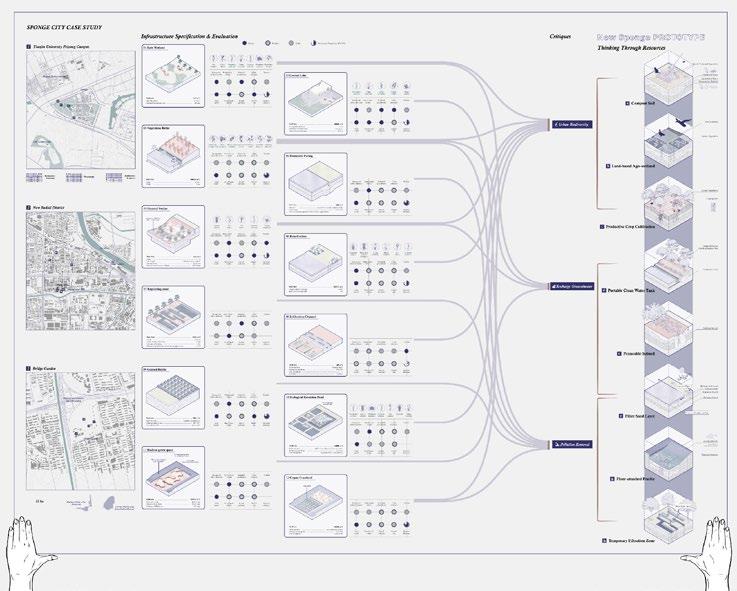


 Supervisor VALIN Ivan Master of Landscape Architecture (MLA)
Supervisor VALIN Ivan Master of Landscape Architecture (MLA)
University of Hong Kong Division of Landscape Architecture Annual 2020-21 30 香港大學園境建築學部設計年鑑 2020-21
Student : ZHANG Yuchen The
Deconstructing the Myth of “Water Scarcity” : A multiscalar approach to landscape stewardship for water equality and resilience at the Shenzhen-Dongguan border
Master of Landscape Architecture (MLA)
Student : LIU Ruixiang
Supervisor : LU Xiaoxuan




University of Hong Kong Division of Landscape Architecture Annual 2020-21 32 香港大學園境建築學部設計年鑑 2020-21
The
Master of Landscape Architecture (MLA)
Producing Peatland : Landscape strategies for reorienting the capital and habitus of peatland’s scientific production in United Kingdom
Prod u c i n g Peat l a n d : L a n d sca p e s t rate g ies fo r re o r e nti n g th e ca pi ta l a n d h a b i tu s of p eat l a n d s sc ie ntific p rod u c tio n i n U n i te d Ki n g d o m by LO Wa i Chi n g S u p e r viso r KE LLY A s h l ey Scot t M as te r of La n d sca p e Arc hi te c tu
Student : LO Wai Ching
Supervisor : KELLY Ashley Scott






Th e U n ive rs i t y of H o n g Ko n g D ivis o n of L a n d sca p e Arc hi te c tu re An n ua l 2 02 0 -21 3 8 香 港 大 學 園 境 建 築學 部 設 計 年 鑑 2 02 0 -21
re (M L A)
The University of Hong Kong Division of Landscape Architecture Annual 2020-21 34 香港大學園境建築學部設計年鑑 2020-21
Master of Landscape Architecture (MLA)
From "Sea Desert" to "Brine Shed" : An incubator system with a decentralized desalination strategy


 Supervisor : ECHEVERRI Natalia Student : CHAN Sau Kai
Supervisor : ECHEVERRI Natalia Student : CHAN Sau Kai
The University of Hong Kong Division of Landscape Architecture Annual 2020-21 36 香港大學園境建築學部設計年鑑 2020-21

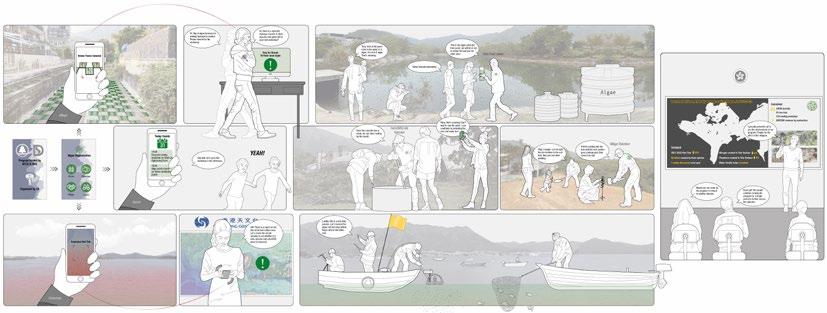




 From Problem to Solution : Role of algae in sustainable water management in Hong Kong Supervisor : TRUMPF Susanne
From Problem to Solution : Role of algae in sustainable water management in Hong Kong Supervisor : TRUMPF Susanne
39 The University of Hong Kong Division of Landscape Architecture Annual 2020-21 38 香港大學園境建築學部設計年鑑 2020-21
Stress Reduction Mechanism Exploration for Urban Park Design : Taking Hangzhou's public park heavily used by IT people as a study model Supervisor JIANG BIn Student : CHEUNG Kai Yin Student : HU Xueling Master of Landscape Architecture (MLA)
Master of Landscape Architecture (MLA)
Student : LI Yuchan The
Edible landscape for carbon sequestration
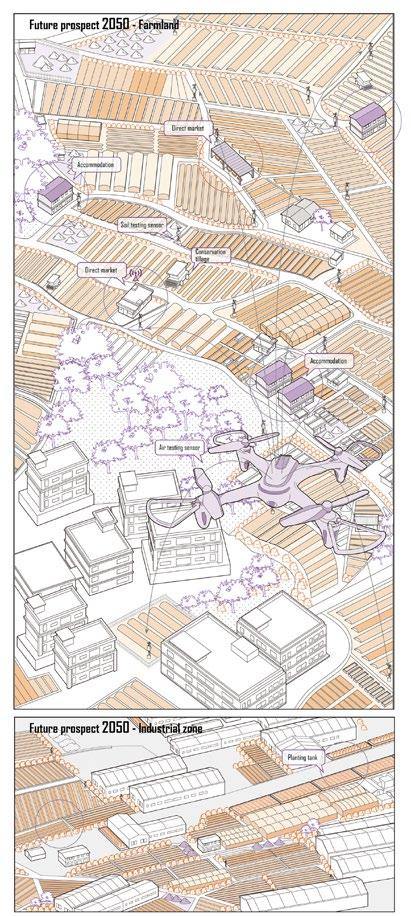

Student : HUANG Congrui
Supervisor : PRYOR Mathew
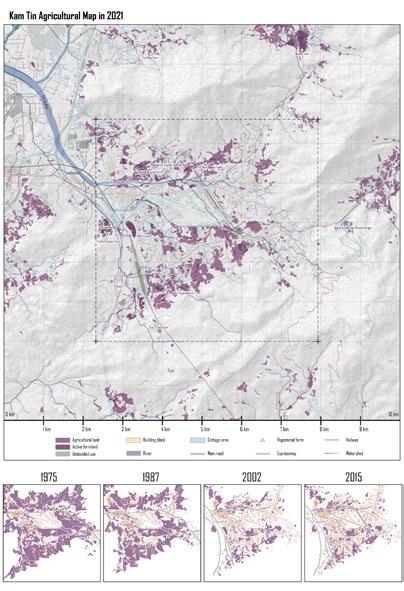

Rethinking Revitalization Adaptive strategies for improving and revitalizing country park enclave villages under the OZP Supervisor : MAK Vincci


University
Division
Annual 2020-21 40 41
of Hong Kong
of Landscape Architecture
香港大學園境建築學部設計年鑑 2020-21
香港大學園境建築學部設計年鑑 2020-21
Master of Landscape Architecture (MLA)
Reimagination of Crises and Urbanism : A study of neighbourhood-scale incidence and landscape control measures as inhibitors of Dengue epidemics in Hong Kong



public space

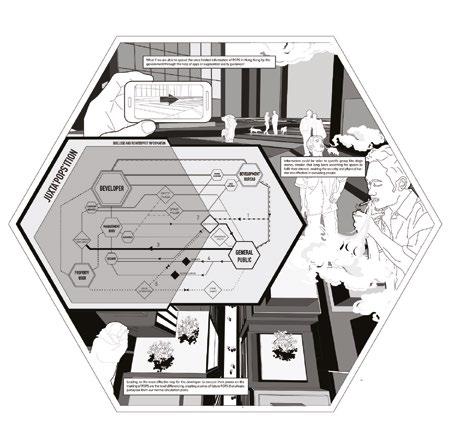

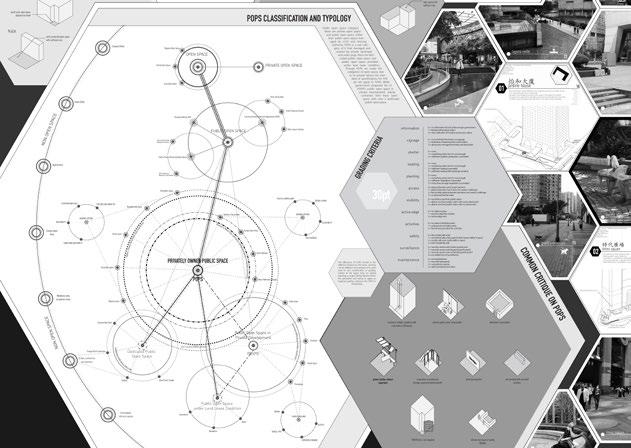

University of Hong Kong
of Landscape Architecture Annual 2020-21 42 43
Supervisor : REN Chao POPS : The reimagination of privately-owned
Supervisor : DECAUDIN Maxime Student : LIU Yun Student : CHIU Ho Wan The
Division
Traversing the Transect
Reconsidering Village Development at Lei Yue Mun
Instructors : CHAN Yin-Lun GULA Roger VIEIRA Valter
Teaching assistants : LIU Ray WANG Yadian
This course explored the core skills and practices related to landscape planning and site design and in the context of the surroundings of Lei Yue Mun (literally Carp’s Gate), a village and former quarry site located at the eastern gateway into Hong Kong’s Victoria Harbour. By beginning with sectional analyses, students were to come up with landscape systems strategies that tackle the environmental, social, and cultural issues of the site that are related across multiple scales — from the detail of an edge, to the structure and organization of community spaces, and ultimately, to larger contexts of the area.
The concept of the ‘transect’ organized the research, site explorations, and design this semester. The transect is an important conceptual model and planning tool in landscape planning and design. It suggests a way of working that is sectional rather than planar, and systematically considers the characteristics and dynamics within and across transect zones. Habitats, communities, and infrastructure at steep site are often linearly organized along contour lines — the use of transects imply an ambition to cut across these layers, discovering the relationships between them and to the form, substrates, and topography of the site. As a form of sectional exploration, the transect also implies an approach to site that is deeply layered and concerned with the materials and structures below the ground, or the flows and atmospheres that rise above it.

ARCH 7131 / Landscape Design Studio I
The Deck : A landmark as the village engine by TAO Ruimin 45 The University of Hong Kong Division of Landscape Architecture Annual 2020-21 44 香港大學園境建築學部設計年鑑 2020-21 Master of Landscape Architecture (MLA)
Master of Landscape Architecture (MLA)
ARCH 7131 / Landscape Design Studio I Tranversing the Transect Reconsidering Village Development at Lei Yue Mun


1. "Progression and regression of social encroachment, and speculations of the future" by LIANG Wanying, LO Sheung Miu, TAO Ruimin, TSANG Ka Lai, YAU Hoi Ying, & YEUNG Hei
2. "The inherit intricacy Negotiations between human and ecological communities, biotic environment, natural disasters, and the water’s edge" by CHEN Shaoqi, LAW Pak Lun, LI Xiangyi, LIU Zihan, SUN Shuyang, WONG Wae Ki Sammi, & WU Yan
3. "Coastal evolution" by LAW Tsz Ho Ivan
4. "The Deck : A landmark as the village engine" by TAO Ruimin



1. 2. 4.
3.
The University of Hong Kong Division of Landscape Architecture Annual 2020-21 46 47 香港大學園境建築學部設計年鑑 2020-21
Studio HK : Landscape Peripheries
Radical-incremental Approaches for Developing South and East Islands
This year's second core MLA studio engaged the dynamic natural systems and contested territories along the coastal edge of Hong Kong Island. The studio's origin was the Hong Kong Coastal Trail, a working proposal for restoring pedestrian and recreational trails to create a continuous path around the island. Students worked with this initiative as a catalyst for additional strategies and interventions that amplified the connective, regenerative, community-focused ambitions of the existing plans.
Students worked through a series of exercises framed at different scales to develop their proposals. The fist exercise examined the variety of landscape systems and communities that are crossed by the proposed trail right of way. After detailed spatial and material documentations, students isolated a user and designed an interface that augmented, adapted, or modified that user's exchanges with the site. In a second exercise, students focused on 6km section of the trail and used maps and sectional diagrams to illustrate the network of relationships, decisions, and agencies that underlay the coastal trail’s development and structure its potential within the larger urban and ecological territory. The final proposals included landscape-led interventions augmenting the original trail planning to conserve critical habitat or improve water retention; expand the possibilities for green or multi-functional civil infrastructure; or to support local communities through access, mobility, and revitalization projects.
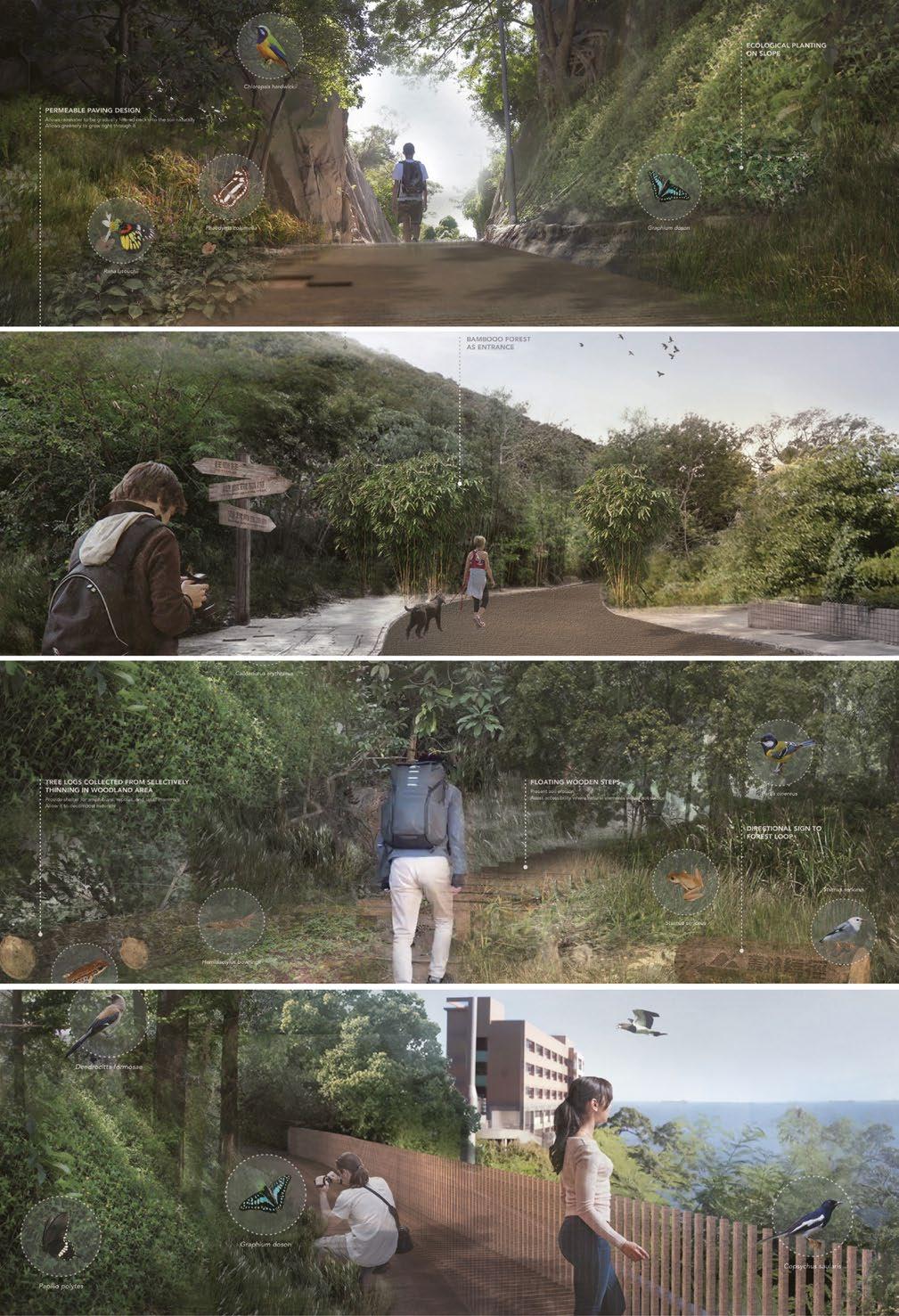 Instructors : VALIN Ivan TRUMPF Susanne KOKORA Michael
Teaching assistant WANG Yadian
Instructors : VALIN Ivan TRUMPF Susanne KOKORA Michael
Teaching assistant WANG Yadian
Wildlife conservation through incremental connective interventions by CHENG Lai Wa ARCH 7132 / Landscape Design Studio II
49 The University of Hong Kong Division of Landscape Architecture Annual 2020-21 48 香港大學園境建築學部設計年鑑 2020-21 Master of Landscape Architecture (MLA)
Master of Landscape Architecture (MLA)
ARCH 7132 / Landscape Design Studio II
Studio HK : Landscape Peripheries
Radical-incremental Approaches for Developing South and East Islands


1. Relational Map : municipal planning and private investment by GU Jingnan, SUN Shuyang, TAO Ruimin, & LI Xiangyi
2. New public access points at Tai Tam Bay waterfront by SHIU Shuk Man
3. Wildlife conservation through incremental connective interventions by CHENG Lai Wa
4. Strategies for hydro-resilient seawall in Siu Sai Wan by TAN Zhiyu
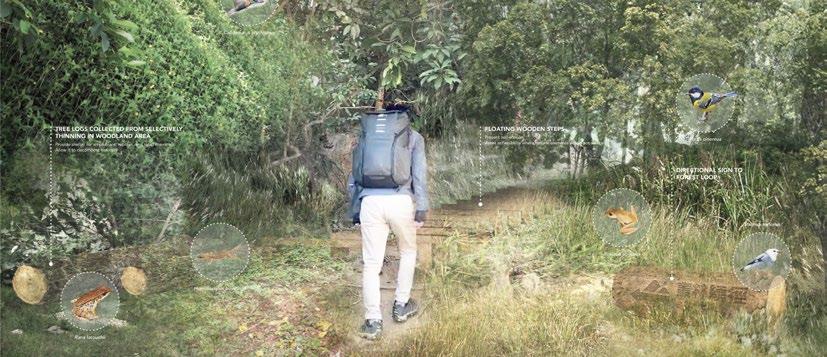

2. 1. 4. 3.
The University of Hong Kong Division of Landscape Architecture Annual 2020-21 50 51 香港大學園境建築學部設計年鑑 2020-21
Communities at the Edge
Negotiating Transitions
and Adaptations in Tung Chung
This advanced design studio investigated the role that landscape design, architecture and planning will have in shaping the land-use, settlement, habitat, and infrastructure of Hong Kong in the face of dynamic social, economic, and environmental change. Hong Kong faces a host of environmental challenges, from predictable decreasing in habitat and environmental degradation, water-pollution, and flooding, to the unknown threats driven by global warming, such as more volatile weather patterns and rising sea-levels. The studio considered Hong Kong as a city in flux. Working between the watershed and the coast, students investigated ecological dynamics, urban transformations, and different transitions at the edge.
The studio worked in collaboration with the MArch Adaptive Tower Studio. For the first project, students explored different transects in Hong Kong where hydrological, ecological, material and structural systems were affected by climate change and sea level rise and defined issues, potentials and relationships to improve the edge. For the final project students, speculated on an adaptive and resilient landscapes in Tung Chung, an area with high ecological value that is threated by urban development. Taking a timeand-process based approach, students developed scenarios that proposing landscapedriven interventions that dealt with development and adaptation. This studio asked: How might the environmental change be leveraged to drive new forms of development and reshape conservation? Can new water and circulation networks increase important native habitats? How can hybrid landscapes of infrastructure and architectural systems offer?

ARCH 7233a / Landscape Design Studio IIIA
Instructor : ECHEVERRI Natalia
"Communities in the Valley, Ecologies of the Estuary : A symbiotic approach for sea level rise" by Poon Cheuk Hei Ryan 53 The University of Hong Kong Division of Landscape Architecture Annual 2020-21 52 香港大學園境建築學部設計年鑑 2020-21 Master of Landscape Architecture (MLA)
香港大學園境建築學部設計年鑑
Master of Landscape Architecture (MLA)
ARCH 7233a / Landscape Design Studio IIIA
Communities at the Edge
Negotiating Transitions and Adaptations in Tung Chung

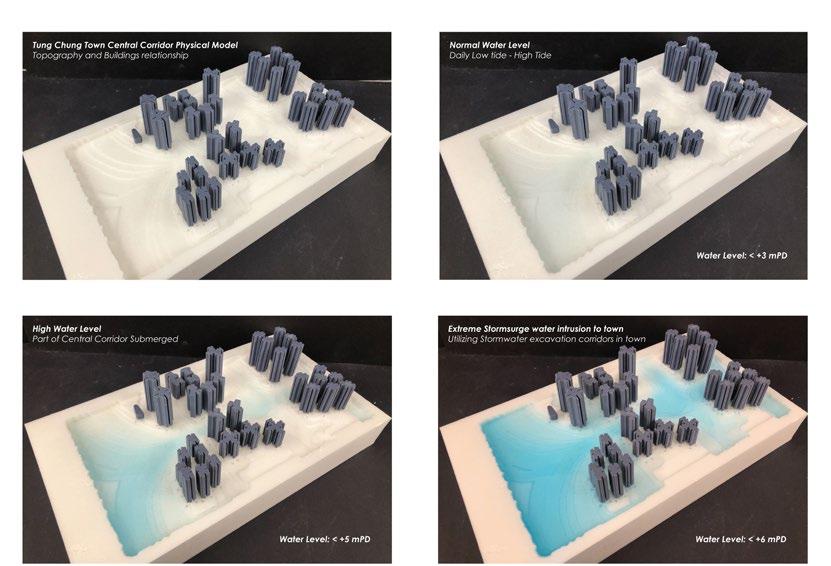
1. “Co-conservation : Save village and horseshoe crab” by LI Yuchan
2. “Dynamic Grounds : A new landscape approach for a water flood network for the reclaimed Tung Chung New Town” by NG Kwok Jing
3. “Reimagining Surface Runoff : A new community-scaled freshwater collection system” by ZHANG Yuchen Kavina
4. “Amphibian Island” by HUANG Ying Lily

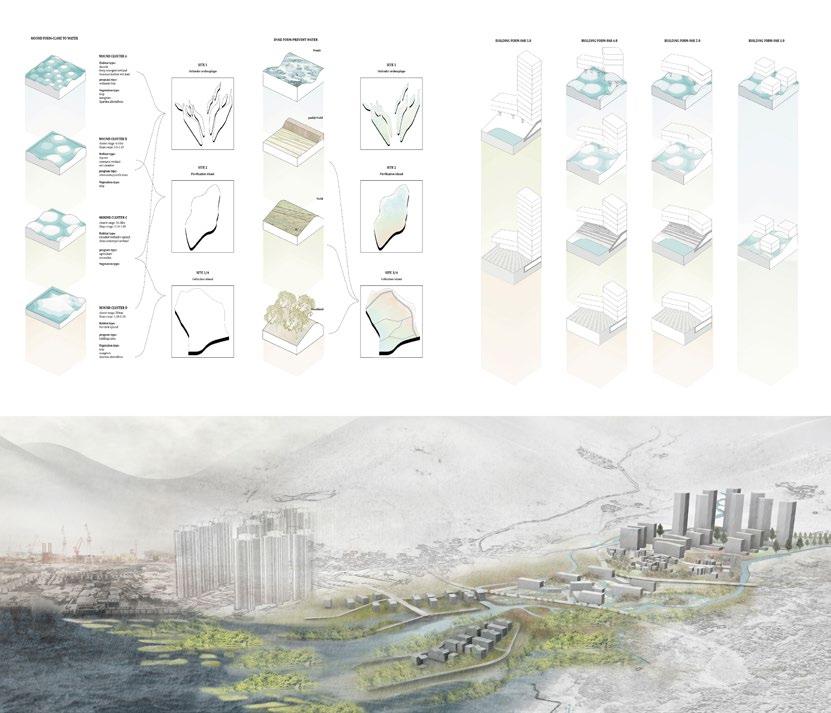
2.
4.
1.
3.
The University of Hong Kong Division of Landscape Architecture Annual 2020-21 54 55
2020-21
Entangled Futures
Designing Posthuman
Landscapes at Lau Fau Shan
Entangled Futures Studio assumed that design does not necessarily serve only the human, and is shaped around ecological thinking. Based on imaginative propositions at the intersection of landscape design, strategic planning, and environmental sciences, the aim of this studio was to engage in issues of sustainability and environmental balance, scarcity of resources (such as food, water, energy), the implementation of lived indigenous knowledge, and maintenance / continuity of ecology and biodiversity. The studio focused on designing landscapes as a habitat for a diversity of life forms and developed proposals for the waterfront at Lau Fau Shan.
Entangled Futures studio started with design research on posthumanism and ecology through case studies of landscape design projects that deal with similar issues as in Lau Fau Shan. Second phase was site research and analysis. Landscape design proposals started with scenario and strategy building focusing on Lau Fau Shan village and the Deep Bay at a larger scale. Following, each student continued with their individual design proposal on a part of Lau Fau Shan waterfront. The methodological assumptions of this studio are that research and design continuously inform each other, design proposal considers the role and responsibilities of the landscape designer, "time" is a medium of landscape design, and "site" is always trans-scalar.
 ARCH 7233b / Landscape Design Studio IIIB
Instructor : BEDIR Merve
ARCH 7233b / Landscape Design Studio IIIB
Instructor : BEDIR Merve
Perspective drawing of smart oyster farm in Deep Bay by CHIU Ho Wan Issac The University of Hong Kong Division of Landscape Architecture Annual 2020-21 56 57 香港大學園境建築學部設計年鑑 2020-21 Master of Landscape Architecture (MLA)
Master of Landscape Architecture (MLA)
ARCH 7233b / Landscape Design Studio IIIB Entangled Futures Designing Posthuman Landscapes at Lau Fau Shan

1. Axonometric drawing of time, labour, and land dynamics in the design proposal by CHAU Li Yin Sabrina
2. Cooperative special nature reserve proposal by LIU Ruixiang



1. 2.
The University of Hong Kong Division of Landscape Architecture Annual 2020-21 58 59 香港大學園境建築學部設計年鑑 2020-21
Living in the Valleys
Alternatives Futures for Hong Kong's Vanishing Landscape Heritage
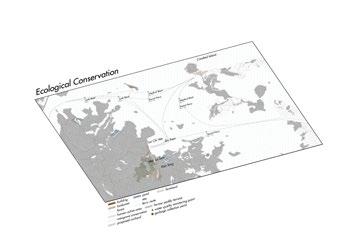
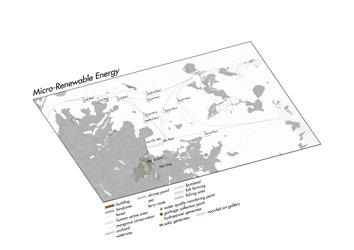

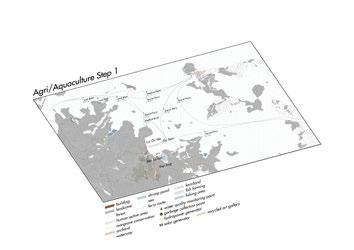

This advanced design studio engaged holistically with Hong Kong’s neglected landscapes heritage through the design of long term scenarios for the valleys of the North East end of the New Territories. By exploring the value of landscape heritage in the distant future, which is unavoidably marked by climate change and a global mass extinction, this studio problematized two forms of contemporary disappearance. First, the loss of historical knowledge and survival strategies which shaped the traditional agrarian landscape and enabled the inhabitants of Hong Kong to live sustainably in the valleys for centuries. Second, the invisibility of the current and future environmental footprint of Hong Kong’s lifeways and the landscapes they generate, both locally and globally. In order to address these issues, students reflected on the following questions through their research, analysis, and design proposals: How can the legacy of abandoned vernacular landscapes in the New Territories become an opportunity to question and rethink the current model of development? What alternatives have already been designed and tested in Hong Kong and globally? And what can be learned from them? What will be the aspirations of future communities and how can they inhabit the land differently? What is the role of landscape architects in designing long term strategies for a sustainable, local, and alternative future?
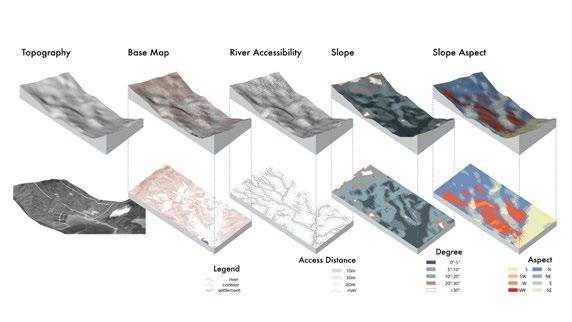

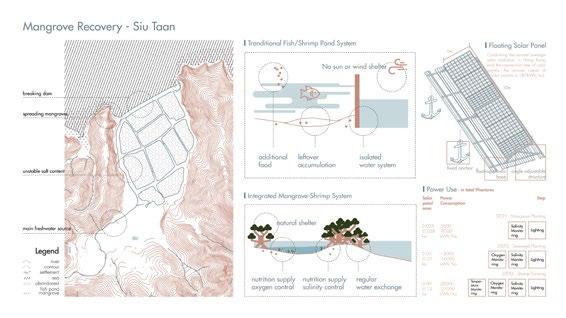
 ARCH 7233c / Landscape Design Studio IIIC
Instructor : DECAUDIN Maxime
ARCH 7233c / Landscape Design Studio IIIC
Instructor : DECAUDIN Maxime
The University of Hong Kong Division of Landscape Architecture Annual 2020-21 60 61 香港大學園境建築學部設計年鑑 2020-21 Master of Landscape Architecture (MLA)
Long term contaminated soil recovery in Lai Chi Wo, Mui Tsz Lam and Kop Tong by CHAN Sau Kai Kurt
Master of Landscape Architecture (MLA)
ARCH 7233c / Landscape Design Studio IIIC
Living in the Valleys
Alternative Futures for Hong Kong's Vanishing Landscape Heritage




1. “Slow-tech incubator for rural conservation start-ups in Lai Chi Wo” by ZHU Zijing
2. “Development scenarios for the landscape heritage of the Frontier Closed Area” by LIU Yun
3. “Sustainable agriculture in Hong Kong” by WANG Yu Fei



1. 3. 2.
The University of Hong Kong Division of Landscape Architecture Annual 2020-21 62 63 香港大學園境建築學部設計年鑑 2020-21
Grading and Drainage
Instructor : COATES Gavin
Teaching assistant WANG Yadian
Landscape Technology I dealt with the way landscape architects work with the land itself, shaping expansive landscapes and constricted urban sites. Lectures in the course addressed topics such as site analysis and responsive site planning, the design of structural elements, soils and earthwork, treatment of existing vegetation, storm water infrastructure and management, and site layout and road design. On this basis, students surveyed levels and plotted contours on campus with reference to as-built construction drawings; mapped surveyed information on plan and plotted accurate sections. They learned how to design and estimate cut and fill earthworks, and how to use contours to clearly illustrate designs. Within the course activities, students used soil components to physically mix fabricated topsoil in accordance with government specifications, plotted the extent of water catchments, and designed paths and steps to resolve access between levels in accordance with regulatory requirements.
The course was integrated with the concurrent ARCH7131 studio (Hong Kong Hybridity). Students worked in groups to produce accurate large-scale as-existing plans and sections of the Lei Yu Mun Headland, the subject area of the studio, which served as base drawings for their individual studio designs. Students in Hong Kong joined a field trip where the relationship between mapping and the reality of the site topography was demonstrated on site. The field trip was livestreamed for the benefit of classmates not in Hong Kong.
In the final assignment, students redesigned an existing courtyard area on campus and produced a basic set of working drawings including as-built, general layout and levels plans, sections and details.

7151 / Landscape Technology I
ARCH
Lei Yu Mun as-existing survey The University of Hong Kong Division of Landscape Architecture Annual 2020-21 64 65 香港大學園境建築學部設計年鑑 2020-21 Master of Landscape Architecture (MLA)
Material, Assembly, and Performance in Landscape Architecture
Instructors :
NG Sylvia TRUMPF Susanne VALIN Ivan
Teaching assistant
CEVALLOS BARRAGAN Francisco
This final course in the MLA program's Technology stream explores the material foundations of constructing durable and sustainable landscapes. The course was broken into sections following issues of material, structure, and documentation — each theme concluding with a research and design project. The first asked each student to research the origins and properties of a landscape material. The collected entries detailed each material's origins, means of extraction, specifying factors, and performance qualities. These observations were developed into a quartet of speculative uses. The second project asked students to analyse two essential landscape structural types: a canopy and a seat. Given our remote learning, students selected a range of strange and surprising constructs from across Hong Kong and China. Students dissected their chosen structural assemblies with a pair of detailed exploded axonometric drawings. In the final project, students were asked to design and detail a structure of their own design. Students designs built on concepts of material and structural legibility, or on revealing traces of fabrication or assembly. Students were pushed to explore the limits of material potential and seek non-standard structural strategies. Designs and their key details were then documented using standard construction documentation and specification language.



ARCH 7254 / Landscape Technology II
Detailed assembly drawing for pedestrian bridge design by YAU Hoi Ying Material speculations for slate micro-plater paving by LUI Ruixiang 67 The University of Hong Kong Division of Landscape Architecture Annual 2020-21 香港大學園境建築學部設計年鑑 2020-21 Master of Landscape Architecture (MLA)
Landscape Plants and Ecology I
Instructor : COATES Gavin
Teaching assistant WANG Yadian
This course enables students to develop an understanding of key ecological principles, and appreciate how these principles underpin successful landscape design and plant selection.
Students were introduced to the main ecosystems of Hong Kong and the concepts of succession, biodiversity, habitat structure, and ecosystem stability. The design component introduced the history, basic principles, vocabulary and process of planting design. Students examined the aesthetic, functional, and ecological characteristics of plants, how they vary over time, and how the designer interacts with these processes. They were encouraged to investigate how these concepts and principles contribute to the success (or failure) of urban landscapes and habitat creation and are an essential tool in successful landscape design.
In terms of horticultural knowledge, students were expected to familiarize themselves with a basic plant palette of commonly found plant species representing a range of urban and rural habitats. Field trips included visits to urban Sai Ying Pun, rural habitats in Mui Wo on Lantau, and to the Fung Yuen Butterfly Reserve near Tai Po to look at a landscape designed for ecological and educational purposes. This semester, face-to-face field trips were recorded by video and supplemented with informative video posts on a dedicated Facebook Workplace site, for reference by Hong Kong based students and those who remained outside Hong Kong.

ARCH 7152
Tree planting plan for Central Waterfront by YAU Hoi Ying Ariel The University of Hong Kong Division of Landscape Architecture Annual 2020-21 68 69 香港大學園境建築學部設計年鑑 2020-21 Master of Landscape Architecture (MLA)
ARCH 7176
Landscape Media
Instructor : KELLY Ashley Scott
Teaching assistants : JIANG Xinjie XIAO Han Pat
Visual communications for landscape architects, as it is taught and practiced, is often appropriated and derivative from technologies and pedagogies of architecture and planning. However, landscape confronts forms, material conditions, and ecological processes more complex than the other design disciplines. Landscape Media is a shift in approach to medium and digital environments. Quickly moving beyond the acquisition of data and the digital automation of repetitive tasks, this course offered a landscapecentric approach to digital media that focused on the manipulation and creation of data, i.e., the “fabrication” of missing information and spatial description across many scales. This required critical and ethical reflection on data organization, spatially explicit methodologies, and the exhibition or reproduction of information in derivative forms. Lectures addressed the evolution of terrain- and surface-based representation and technologies from the origins of Geographic Information Systems (GIS) in the 1960s, 1990s digital revolution in architecture, datascapes, and advancements in point-cloud technologies in the 2000s. For their term projects, students flexed their new digital design theory and skills in digital technology to reflect on a set of Hong Kong-sited landscape ecology literature. These included topics on: historical data integration for long-term modelling of forest succession; high-resolution modelling of urban habitat ecological connectivity; broad-species habitat modelling for tourism planning; cumulative environmental impact assessment; and geotechnical slope stability risk assessment.


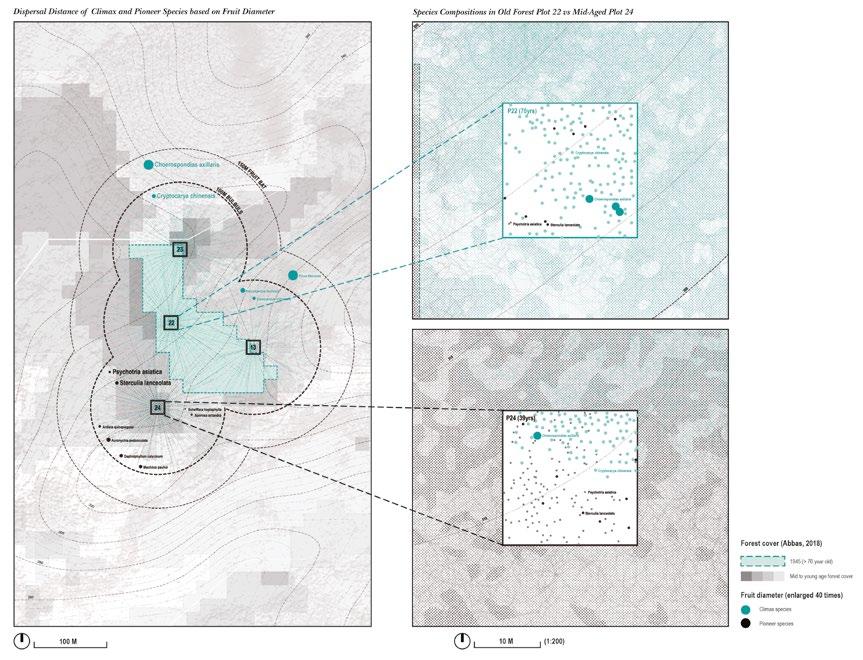
Least cost path (LCP) explorations of habitat connectivity across ecological scales in Kowloon by LAW Pak Lun, LAW Tsz Ho Ivan, & YEUNG Hei Exploration of forest succession, dispersal, and composition at multiple sites over 70 years on Tai Mo Shan by TAN Zhiyu, YAU Hoi Ying Ariel, & ZHOU Hongqiao 71 The University of Hong Kong Division of Landscape Architecture Annual 2020-21 香港大學園境建築學部設計年鑑 2020-21 Master of Landscape Architecture (MLA)
ARCH
Theories and Practices of Contemporary Landscape Architecture
Instructors :
LU Xiaoxuan XIAO Han Pat
Teaching assistant CEVALLOS BARRAGAN Francisco
The discipline of landscape architecture has been transformed over the past few decades with the advent of new sets of theories and agendas formulated by landscape theorists and practitioners. Various protagonists have set out to reconceptualise the roles of landscape architecture and its field of operations. At the same time, a related set of intellectual currents has arisen to challenge our pre-existing ideas of ‘landscape,’ ‘nature,’ ‘culture,’ ‘environment’ and so forth. Such intellectual transformations lead to the emergence of new design and planning methodologies and subsequent spatial outcomes, which acknowledge and respond to changing ecological, economic, and social conditions.
This course sought to understand these contemporary positions by tracing their developments from the late 19th to 21st centuries. It posited that history, theory and practice are contingent upon one another and, together, they ground design in the particularities of time and place. The course began by examining the emergence of modern landscape architecture and design thinking in different contexts as well as the changing relationship between the discipline and other fields over the 20th century. Concurrently, it focused on exploring the standard landscape concepts, such as site, form, and ecology, particularly the ever-changing approaches to and definitions of these concepts.
Academic research and essay writing are the primary means for articulating ideas and positions in landscape architectural history and theory. Students were required to produce a scholarly, thoroughly-researched and well-argued critical essay on a case study in or related to landscape architecture.

7141 / ARCH 3105 (BA(LS)) / Landscape History and Theory I
at Laurierstraat, Amsterdam. Aldo van Eyck, 1965.
Playground
The University of Hong Kong Division of Landscape Architecture Annual 2020-21 72 73 香港大學園境建築學部設計年鑑 2020-21 Master of Landscape Architecture (MLA)
Photo by Ed Suister.
Wan Chai in 50 years- Smarty City
Sensors and cameras collect data and generate information. Information obtained from the computers was then used to manage resources and services
ARCH
History and Theory II Strategic Landscape Planning
Instructor : JIANG Bin
Teaching assistant WANG Ting
I have imagined wan chai as a smart city in 50 years. AI will take place in most situations, such as Sensors and cameras collecting data and generates information. Information obtained from the computers was then used to manage resources and services. Robots such as the greenery robots can do all the weeding, pruning, and irrigating works. It will also be great to see the increasing vertical greenery and urban forestry taking place, reducing the heat absorption of the concrete structures. Hence, reduce the urban heat island effect and thermal discomfort of the district. Furthermore, sensors and cameras collect data and generate information about the community. Information obtained from the computers was then used to manage resources and services, helping to build a more vibrant and safer community.
This course undertook a critical evaluation of the global contemporary practice of landscape architecture and planning at the urban and regional scales. Shifts in global economic and geopolitical trends have necessitated a repositioning of these practices from an empirical, socially, and environmentally deterministic practice to one that is operative and catalytic, for which strategy and negotiation prevails over traditional top-down planning methods. This course aimed to situate these diverse and often contradictory ideas about shaping of our environment within a historical continuum and the struggle over disciplinary identities, while simultaneously exploring their impact on the evolution of methodology and ethics.
Scenario Board 2
Drones used for deliveries and crime monitoring
Increasing vertical greenery and urban forestry can reduce the heat absorption of the concrete structures.Hence, reduce the urban heat island effect and thermal discomfort.
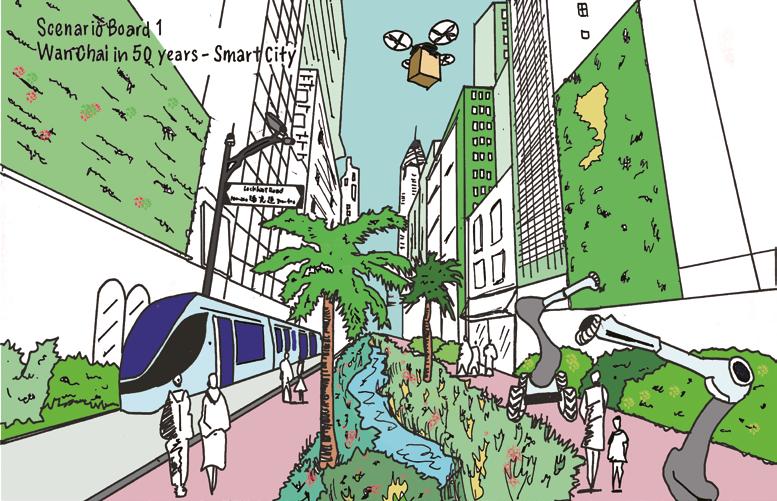
Sustainable public transport: Automated and solar power trams
Wan Chai in 20 years- Harmonious community
The course started with a brief historical overview of the origins and the social, industrial, and economic contexts of contemporary landscape design and planning at urban and regional scales over the past century. This portion of the class treated essential contemporary texts that attempt to reposition and expand the landscape discipline for 21st-century urban challenges. A rereading of various typologies of green modernist urbanism, particularly relevant to contemporary design culture including the mat, field, pattern, and patch was explored.
The course then turned to explore in some detail the various responses in landscape architecture and related disciplines to recent interrelated developments shaping the context of contemporary practice. Subjects covered in this portion of the class include: the reshaping and / or explosion of cities through globalization and changes within political economies, the emergence of environmental consciousness and crisis, technological and particularly computational advances. These developments, together with shifts in thinking and conceptual frameworks have prompted landscape architects to engage in more strategic, catalytic modes of practice to advance landscape architects' central relevance and specific disciplinary expertise in designing at these scales.
The general idea for scenario two is, within 20 years. Gloucester Road can be wholly reconstructed into a public open space and pedestrian walkway, uniting Southern and Northern Wan Chai and allowing the Northern Wan Chai to become a part of the local community. This can significantly boost the amount of "air spaces" and improve the air ventilation of South Wan Chai. Traffic roads can also be brought entirely underground to diminish the air pollutants and urban heat island effects in Wan Chai.
Intelligent Public transport Systems will also be introduced. Technologies may include real-time information flow between commuters and transport providers, Artificial Intelligence (AI), and smart algorithms, which allow for the rapid processing of information of the transportation network.
Creating linkage between patches; Urban forestry enhance biodiversity
AI technology: Greenery maintenance robots (Weeding, pruning, pesticides, irrigating)
Transforming the entire Gloucester Road into public open space and pedestrian walkway. Connecting Southern and Northern Wan Chai. Drones used for deliveries
Use of organic resin-roads, Eco-Pave.
Promoting Wan Chai as a bicycle oriented district, by building cycling circuits connecting the Southern and Northern Wan Chai

Traffic roads can be brought underground, in order to reduce the air pollutants and urban heat island effects in Wan Chai
technologies include real-time information flow between commuters and transport providers
More recreational facilities improves mental health of residents
“Wan Chai in 20 Years : Harmonious community ” by CHEUNG Kwan Ho
Increasing the area of “air spaces” and improve the air ventilation of South Wan Chai.
Cheung Kwan Ho 3035453440
7142 / ARCH 4705 (BA(LS)) / Landscape
The University of Hong Kong Division of Landscape Architecture Annual 2020-21 74 75 香港大學園境建築學部設計年鑑 2020-21 Master of Landscape Architecture (MLA)
ARCH 7281
Landscape Architecture Practice
Students were given the opportunity to consider post-academic, working life by adopting professional working outlooks and habits during thirteen weekly sessions. Utilising immersive activities, students were able to become more familiar with the basic principles, common concerns and requirements of landscape architectural practice, including an understanding of: behaviour, ethics and professionalism; landscape services and consultancy; project team, practice and construction management; procurement and contract requirements.
Working in groups, the weekly deliverables were presented by students via video and other online media utilising zoom conferencing. The peer group were able to engage in discussion and debate, whilst real time assessment apps were utilised to provide feedback on presentations. Innovation, creativity and research skills were prized and students were challenged through the needs for teamwork, project management and assessment of peers. All deliverables were continually augmented by developing a course website platform which aims in future service as a professional practice handbook.
See more on https://landscapepropractice.wixsite.com/website.
Instructor : WILSON Barry
Teaching assistant CEVALLOS BARRAGAN Francisco

76 77 The University of Hong Kong Division of Landscape Architecture Annual 2020-21 香港大學園境建築學部設計年鑑 2020-21 Master of Landscape Architecture (MLA)
Tree Management in Urban Landscape
This course, which was presented essentially online apart from occasional site visits, was designed to provide students with the essential background knowledge required to successfully manage trees in the urban landscape. After taking an initial overview of the physical and commercial contributions that trees make to the overall quality of life in the urban areas we then looked at Trees and the Law and the obligations faced by managers who are responsible for trees in facilities coming under their “duty of care”.
Students were then guided through the process of how to select various trees for different situations not only by reference to their physical characteristics but also to appreciate what constitutes a “good” tree in terms of its health, form and architecture.
Following an introduction to the drafting of a typical Tree Survey and how to approach Tree Risk Assessments by using practical examples pointed out during a field trip, students were guided through the standard formatting for Tree Surveys with explanations given for each of the component parts of a Survey.
An important part of the course looked at how to assess / appraise trees suitable for transplanting and under what circumstances they can be transplanted taking into account various site constraints, species limitations, tree ages, etc. using examples that we found during our field trips.
After reviewing the difficulties associated with, and the techniques developed for, the preservation and protection of trees within construction sites in Hong Kong and how to manage the process from early assessment of the site through to the provision of physical protective measures and management techniques for handling contractors and employers students were introduced to the value of using Inventories in the management of the urban woodland.
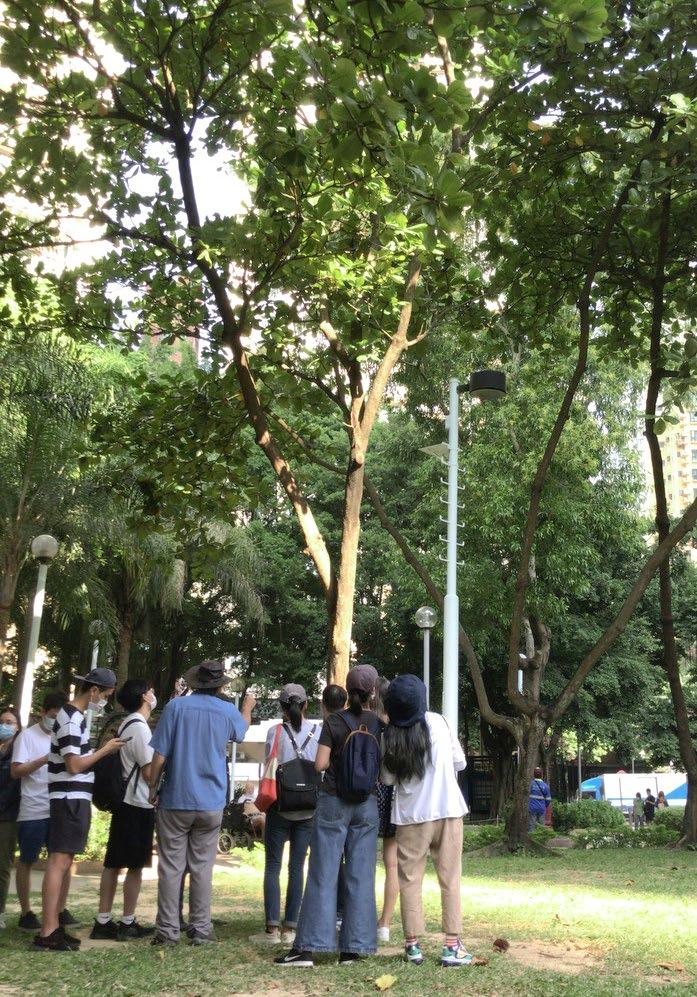
Field trip to Kennedy Town
ARCH 7306 / Urban Arboriculture
Instructor : ROBINSON Ian
79 The University of Hong Kong Division of Landscape Architecture Annual 2020-21 78 香港大學園境建築學部設計年鑑 2020-21 Master of Landscape Architecture (MLA)
Teaching assistant CEVALLOS BARRAGAN Francisco
“Landscape as Development” was a technology-theory seminar that surveyed the epistemological and practical gap between ecological planning (as construed by landscape architecture) and biological conservation. This course was designed to facilitate critical reflection on the selection and appropriation of secondary scientific research for environmental planning practice and policy. The course’s reading list was a mix of: a) foundational texts in landscape architecture, landscape planning, and landscape ecology; b) novel papers in spatial ecology; and c) case-based literature from science and technology studies (STS), land change science, and political ecology. We focused equally on theory, bridging between the design disciplines and the axioms, problem framing, and project types of the above conservation-related fields, and building students’ technical geospatial skill sets for working within complex and contested natures. Students’ term projects for the course introduced them to how landscape ecologists and landscape scientists are engaging a major ongoing international development plan, this year focused on the China-Myanmar Economic Corridor (CMEC) running from Ruili in Yunnan to Rakhine State in Myanmar via Mandalay. In-class workshops helped students develop an understanding of this corridor as an assemblage of pre-BRI (Belt and Road Initiative) development projects and critically assess plans for its improvement and conservation.



/ Advanced
ARCH 7307
Topics in Sustainability Landscape as Development
“Constraints in criticality : A Review of WWF’s position on the Belt and Road Initiative in Myanmar” by TANG Kenji
Instructor : KELLY Ashley Scott
Teaching assistant
“A Human-ecological reaction to WWF’s use of ecosystem services prediction for infrastructure planning in Myanmar” by WEI Gongqi William 81 The University of Hong Kong Division of Landscape Architecture Annual 2020-21 香港大學園境建築學部設計年鑑 2020-21 Master of Landscape Architecture (MLA)
CEVALLOS BARRAGAN Francisco
The Politics and Poetics of Infrastructure
Responding to contemporary ecological pressures and current high demand for infrastructure development worldwide, this course brought together a series of thinkers and researchers from the design commons across Eurasia to discuss different methods, models and measures of large scale, long range infrastructure projects for the 21st century. This course challenged the commonplace assertion that the work of infrastructure remains invisible until it fails. Instead, It opened a horizon on infrastructure’s cultural valence that remains primarily symbolic — of technological development, of political patronage, of resistance to sovereign power.
In addition to the weekly guest lectures and occasional screening of films, students worked in pairs to develop a videographic essay. Focusing on the multilateral transnational infrastructure development projects at China’s borderlands that are playing a significant role in current Chinese initiatives to create transnational China-centric development corridors, these videographic essays explored the following questions: How are environments and infrastructures built? Who builds them? What materials are required? What influences and forces act upon them? How are they changing? Through digital means, students explored and interpreted historic spatial processes and contemporary ecologic patterns to open a new lens on urbanization, where representation is, in and of itself, a form of research.

ARCH 7343 / Advanced Topics in Urbanism
Instructor : LU Xiaoxuan
Term project focused on the Dongxing-Mongcai border port between China and Vietnam by AN Xiaomeng and LI Yulan 83 The University of Hong Kong Division of Landscape Architecture Annual 2020-21 82 香港大學園境建築學部設計年鑑 2020-21 Master of Landscape Architecture (MLA)
ARCH 7342 / Advanced Topics in Landscape Architecture Theory
Environmental Psychology, Behaviour and Well-Being Theory, Scientific Evidence, and Design Applications
This course examined the complex relationship among quality and characteristics of urban environments and human’s psychology, behaviour, and well-being status. The main objectives were promoting designers’ critical thinking skills, research skills, and encouraging evidence-based design approaches. The course led students to observe, analyse, and understand people’s mindsets, behaviours, and status in their daily life within a specific physical, cultural, and economic context. Then, students can use the knowledge and skills to develop their own design philosophy, methods, and concepts for creating appropriate living environments for people. The course demonstrated and explained theories, scientific evidence, and design cases on multiple types of urban environments. Each class included a short presentation & comments time, a formal lecture, and an intense workshop. In each workshop, the instructor worked with students on a design or research issue about each type of environment.
Instructor : JIANG Bin
Teaching assistant XU Wenyan

The University of Hong Kong Division of Landscape Architecture Annual 2020-21 84 85 香港大學園境建築學部設計年鑑 2020-21 Master of Landscape Architecture (MLA)
The comparison between old citizens who have improved living conditions and other old citizens who haven’t by HUO Chunyu Kiki
ARCH 7381 / Advanced Topics in Landscape and Urban Research Methods
Design for Changing Climate
The course introduced the physical basic knowledge of climate change and urban climate and climate-responsive design strategies to students. During the class, changing climate impacts upon the built and natural environment were discussed among students. The course helped students to apply the learnt knowledge and skills into their design projects for understanding the climate conditions and challenges of their design sites and creating better living environment performance. Students were teamed up for conducting their group project. A local community was selected by each group based on their interest and local environmental issues. They conducted weather data and site environment information collection for analysing local climate-environmental conditions and developing their climate-responsive design improvements. Apart from group project, each student wrote an individual essay to holistic review the real climate actions conducted in one selected city. This assignment helped students to understand the real needs and practical experiences of climate-responsive design.


 Instructor : CHAO Ren
Instructor : CHAO Ren
ENVI-met simulation results by LO Wai Ching, POON Cheuk Hei Ryan, & CHAN Ka Cheong Derrick, and Urban morphology analysis of Wanchai area TANG Donglin The University of Hong Kong Division of Landscape Architecture Annual 2020-21 86 87 香港大學園境建築學部設計年鑑 2020-21 Master of Landscape Architecture (MLA)
One of the major differences between Landscape Architecture and Architecture is an appreciation for, and understanding of, horticulture and arboriculture and their influence on the design process.
Horticulture and Design
This course addressed most of the common issues and was geared towards providing the student with the basic knowledge required in order to make informed decisions and produce relevant designs with regard to the horticultural aspects of Landscape Architecture.
The course dealt with botanical and horticultural principles and practices in relation to design. It covered the hierarchical nature of the plant kingdom, the physiological relationships between structure and function of plant organs, responses of plants to environmental factors, gaining an understanding of the techniques used for plant multiplication, practical techniques for plant installation, how to manage the planting of interiorscapes, roof structures and green walls, the management of landscaped sites in terms of nutritional requirements and control of pests and diseases and the selection of grass types for a range of uses. The course also looked at the essential Contract Documentation required for the letting and subsequent management of both landscape implementation and maintenance contracts.

7305
ARCH
Instructor : ROBINSON Ian Teaching assistant JIANG Xinjie
88 89 The University of Hong Kong Division of Landscape Architecture Annual 2020-21 香港大學園境建築學部設計年鑑 2020-21 Master of Landscape Architecture (MLA)
Field trip to urban parks
ARCH 7291
Thesis Preparation
Methods of Enquiry for Landscape Architecture Thesis
Thesis Preparation introduces students to the basic parameters of a thesis and equips them with the necessary skills for carrying out their thesis research in the spring semester. The course provides an overview of common practices of qualitative research in landscape architecture and other built environment disciplines. Course assignments are designed to help students to define the scope of their thesis, frame relevant research questions and arguments, and become familiar with the types and usage of reference materials for their projects. Lastly, the course enables students to articulate a critical intellectual position through the development of a tentative thesis topic, and by doing so deepen their understanding of the significant role of research in design practice.
This is principally a seminar course with the instructor serving as discussion leader. The course comprises lectures, discussions and other specified inclass activities. Weekly readings are assigned to students, who are expected to complete them prior to the start of the next class. A total of 5 assignments are required, including a thesis proposal, which is due at the end of the semester.
Instructor : CHU Cecilia Louise
Teaching assistant CEVALLOS BARRAGAN Francisco

91 90 The University of Hong Kong Division of Landscape Architecture Annual 2020-21 香港大學園境建築學部設計年鑑 2020-21 Master of Landscape Architecture (MLA)
Thesis presentation by CHAU Li Yin Sabrina
ARCH 7190
MLA Prerequisite
This two-week intensive course gave students an introduction to the Division of Landscape Architecture, to the teaching of the MLA curriculum, and to the urban landscapes of Hong Kong. Lectures, workshops, and tutorials provided inspiration and practical skills guiding students to understand and represent the interrelations of nature and culture of the city.
Students worked in assigned groups to record and map intangible sets of relationships investigating a series of places from the waterfront through the urban core to the natural fringe of the city. These urban-ecological transects were analysed within their wider ecological context as well as for their intrinsic environmental and spatial qualities.
During this remotely taught course, students were responsible to plan and curate site visits in small groups. Students who were not present in the city complemented the fieldwork with research of published records and documents including historical and present-day maps, government and industry databases, study reports and aerial photographs. They rigorously analysed, categorized, and documented their different observations leading to a collective understanding of the diverse landscape features across Hong Kong Island and Kowloon.
Instructor : TRUMPF Susanne
Teaching assistants : CEVALLOS BARRAGAN Francisco
WANG Yadian
WONG Wing Yin Erica

The University of Hong Kong Division of Landscape Architecture Annual 2020-21 92 93 香港大學園境建築學部設計年鑑 2020-21 Master of Landscape Architecture (MLA)
Aberdeen field archive by FU Qiying, FUNG Ngo Ching Louisa, HUI Chun Sing, LAU Cheuk Ying Cherry, & SHIU Shuk Man Katie

MLA thesis review
Postgraduate Diploma in Landscape Architecture
PDLA 園境深造
文憑課程 The University of Hong Kong Division of Landscape Architecture Annual 2020-21 96 香港大學園境建築學部設計年鑑 2020-21
Uncovering Site and Process in the Landscape
Assemblies, Gradients and Frameworks
This foundation studio explores the act of revealing the dynamic landscape as an essential skill of the landscape architect. Through drawing, rigorous observation, and design experimentation, students documented ephemeral or hidden processes in the natural landscape and illuminated the impacts of standards and constraints on the urban public realm. In representing landscape in this way, students were challenged to consider alternatives to more traditional drawing methods — favouring 'gradient' over 'boundary', 'networks' over 'objects', and 'parameters' over 'dimensions'.
In the first project 'Sample/Code/Diverge', students examined the elemental structures that negotiate of Hong Kong's steep topography: stairs, ramps, and reinforced slopes. From their selected case studies, students extracted and then drew an 'essential code' for their element. This project explored the generation of specificity and the limits of the 'typical' in the landscape. These 'essential codes' were then used as the basis for a series of iterative design explorations that generated new and hybrid landscape realities. The second project took on the design of a landscape intervention on Lung Fu Shan's Pinewood Battery historic site. Students produced a set of generative maps that traced the dynamics of water and sunlight in combination with soil, slope, aspect, and vegetation. These drawings, together with their expanded toolkit of walls, steps, and ramps from project 1 became the basis for a design intervention aimed simply at revealing and engaging in the dynamic processes on the site.

ARCH 7138 / Foundation Design Studio I
Instructor : VALIN Ivan
Teaching assistant CEVALLOS BARRAGAN Francisco
Landscape “monsters” : Stair and canopy mashups by LAM Pui Kwan 99 The University of Hong Kong Division of Landscape Architecture Annual 2020-21 98 香港大學園境建築學部設計年鑑 2020-21 Postgraduate Diploma in Landscape Architecture (PDLA)
ARCH 7138 / Foundation Design Studio I
Uncovering Site and Process in the Landscape Assemblies, Gradients and Frameworks




1. Landscape “monsters” : Parametric deviations of slope and stair by MAN Ting Yan
2. Perspectives by CHAN Ching Yin
3. Site plan with habitat mapping by LAU Fong Yui

1. 2. 3.
The University of Hong Kong Division of Landscape Architecture Annual 2020-21 100 101 香港大學園境建築學部設計年鑑 2020-21
Architecture (PDLA)
Postgraduate Diploma in Landscape
Terrained Open Space
Instructor : MAK Vincci
Teaching assistant
This project took Sheung Wan as a study ground in order to explore its formal and informal open spaces.
Sheung Wan is one of the oldest neighborhoods in Hong Kong. The area south of Queen’s Road Central is terrained, and early developments were characterized by terraces and staircases to accommodate the topographic differences in the neighborhood. This is rather unique, and the challenge in this studio project is to find ways to create open space in this terrained neighbourhood.
This studio started with an initial exercise to study open spaces in Sheung Wan in order for students to learn about their history, user patterns, modes of development / operation, and space networks. This exercise also aimed to give students some contextual understanding of Sheung Wan and prepare them for their upcoming assignments. After a precedent study that looked at how other landscape projects design open space on topographic sites, the second exercise of the studio introduced the design task and its site. At this stage, students learnt how to do site analysis, and how findings in the analysis can inform design directions.
Students developed a conceptual site plan in the third exercise, demonstrating their understanding of the site’s context, topographic challenges, and access connection network. They incorporated open space programs reflecting the neighborhood’s social dynamics. Toward the end of the project, students were guided to focus on key areas to further their design.
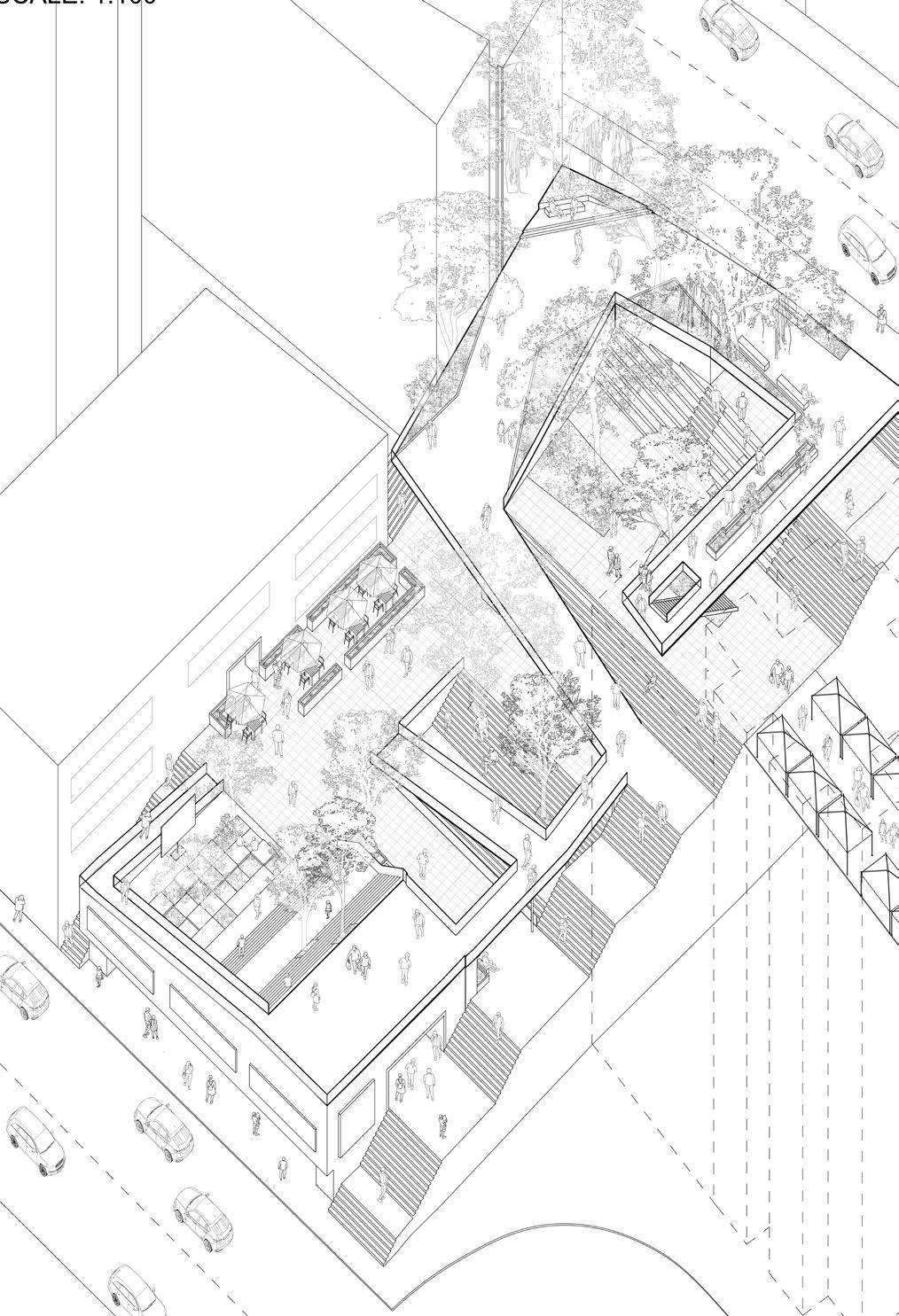
ARCH 7139 / Foundation Design Studio II
CEVALLOS BARRAGAN Francisco
Axonometric drawing by ZHOU Jiaxuan The University of Hong Kong Division of Landscape Architecture Annual 2020-21 102 103 香港大學園境建築學部設計年鑑 2020-21 Postgraduate Diploma in Landscape Architecture (PDLA)
ARCH 7139 / Foundation Design Studio II Terrained Open Space Postgraduate Diploma in Landscape Architecture (PDLA)
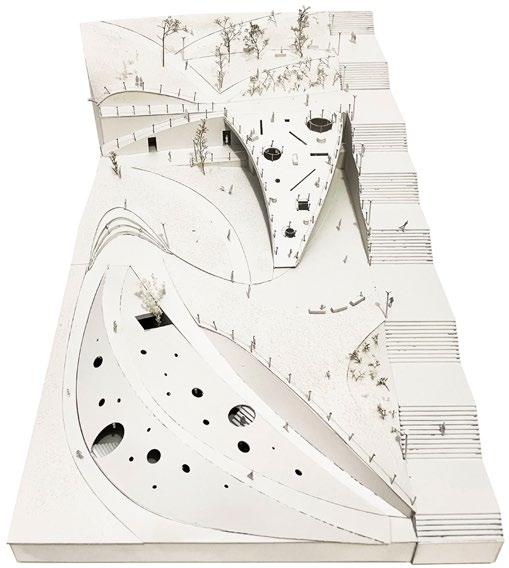


1. Model by CHAN Ching Yin Kurt
2. Sections of Shin Hing Street and Aberdeen Street by CHAN Yee Kwan Yvonne, TSIM Yuenting Jessica, & ZHOU Jiaxuan
3. Model by MAN Ting Yan Natalie
4. Parti diagram by TSIM Jessica Yuenting
5. Key area drawing by LOU Tongyao
6. Key area drawing by ZHOU Jiaxuan


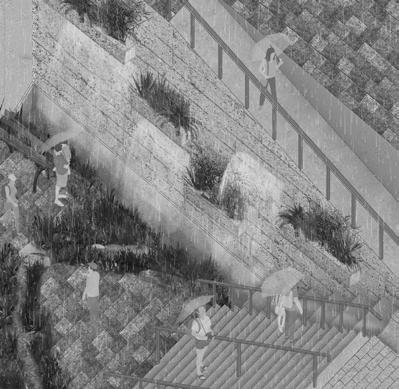
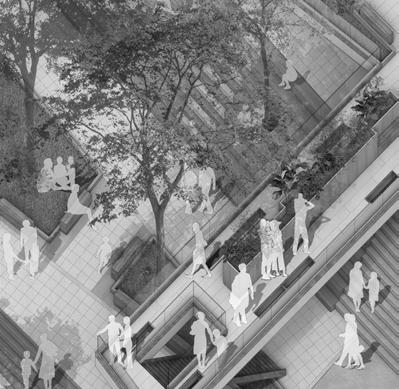
6. 5. 4. 1. 2.
The University of Hong Kong Division of Landscape Architecture Annual 2020-21 104 105 香港大學園境建築學部設計年鑑 2020-21
ARCH 7148
Histories of Landscape
A Disciplinary Exploration
Compared to architecture or geography, the discipline of landscape architecture is relatively recent and the potential it has to offer as a design practice are changing as new areas of intervention are constantly explored by contemporary practitioners. In the context of a worldwide ecological crisis, global warming, artificial intelligence and increasingly unregulated neoliberal economies, the distinctions between nature, science, society and culture are no longer useful frameworks to think the world we live in. Because the idea of landscape is so difficult to define, to delimit, to fix, it useful and offers vast potential to explore new conceptual frameworks.
The objective was to trace the many histories that could potentially influence or even redefine what landscape architecture is today and what it could become in the future. History was explored in its disciplinary and cultural diversity (hence the plural) and understood as a contemporary way to produce alternative futures. The course followed a thematic rather than chronological sequence. Students were encouraged to venture outside of their own disciplinary framework and to explore and define for themselves the disciplinary boundaries of landscape architecture. They engaged critically with definitions of landscape from art, geography, science, archaeology and anthropology, through selected representative case studies. Students became familiar with a wide range of approaches to landscape and develop intellectual positioning through argumentations and debates.
 Instructor : DECAUDIN Maxime
Instructor : DECAUDIN Maxime
106 107 The University of Hong Kong Division of Landscape Architecture Annual 2020-21 香港大學園境建築學部設計年鑑 2020-21 Postgraduate Diploma in Landscape Architecture (PDLA)
LIN Heimen Vanessa presenting the history of play in the city
ARCH 7157
Landscape Systems
The ARCH7151 Landscape Systems course frames ‘landscape’ as an assembly of natural systems (geological, hydrological, climatic, and ecology) in continuous dynamic interaction with human systems (building development, urban infrastructure, materials / waste). Through multiple landscape case-studies, readings, and technical exercises, the class examined some of the theories that underpin our ideas of landscape, and explored the relationships between the built and the natural, at site, district and territorial scales. The course also focused on foundational skills in ‘reading’ landscapes and assessing specific qualities and functions of landscapes. In addition to developing our landscape architectural language, we reflected critically on terms commonly used (and abused) in practice today such as ‘sustainability’ and ‘resilience’, ‘performance’, and ‘productivity.
We centred our landscape mapping and description studies on Shek O, the historic village set on the exposed southeast corner of Hong Kong Island, where both the landscape and the village are very much he project of the environment.
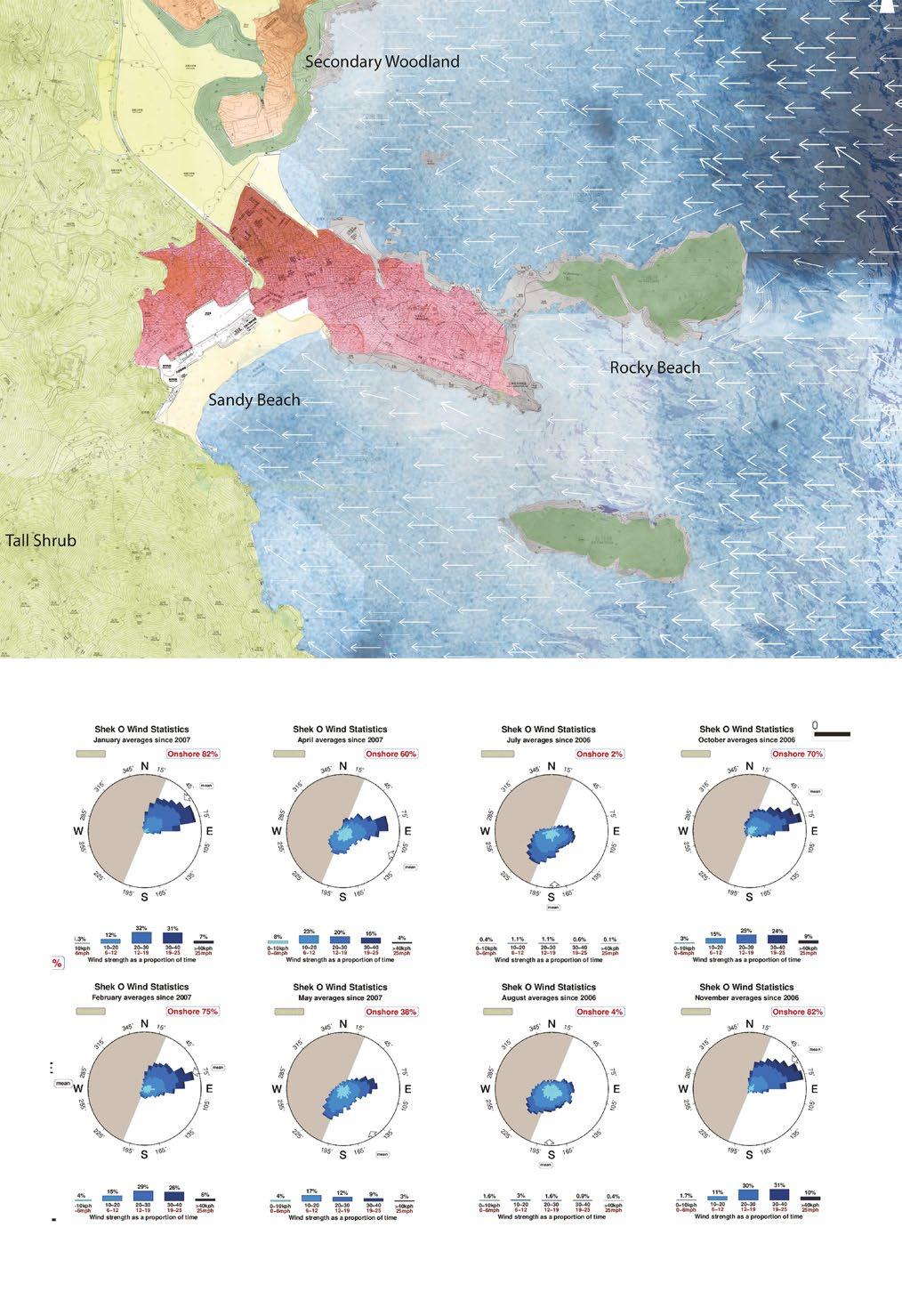 Instructor : PYROR Mathew Teaching assistant JIANG Xinjie
Instructor : PYROR Mathew Teaching assistant JIANG Xinjie
Mapping the interrelationship between wind and vegetation at Shek O by LAM Pui Kwan Candace The University of Hong Kong Division of Landscape Architecture Annual 2020-21 108 109 香港大學園境建築學部設計年鑑 2020-21 Postgraduate Diploma in Landscape Architecture (PDLA)
ARCH 7158
Landscape Technologies and Techniques
This course combines the two primary technologies employed by landscape architects to shape space and function in the landscape: landform and planting design. The three-dimensional literacy and observation skills required to articulate these elements are introduced through various landscape representation techniques.
The relationship between planting, topography, and human intervention and behaviour in the landscape was explored during a field trip to Yuen Long Town Park.
Other field trips included a Soil Workshop with David St Maur Sheil where students were introduced to the fundamental importance of soils in landscape. During a visit to ArkEden on Lantau students watered and applied fertilizer to tree seedlings planted on eroded slopes, sketched the landscape from life, experienced the reality of topography and how it corresponds with contour maps, and observed children’s nature-based education in action.
At the end of the course, students reflected on their experience of the course and demonstrated that they had gained invaluable skills and insights into the basics of the technologies and techniques required for landscape design.
Instructor : COATES Gavin
Teaching assistant WANG Yadian

As-existing section by LOU Tongyao Vivienne
The University of Hong Kong Division of Landscape Architecture Annual 2020-21 110 111 香港大學園境建築學部設計年鑑 2020-21 Postgraduate Diploma in Landscape Architecture (PDLA)
What are the extents and limits of architects and planners’ power to affect environmental and social change? How do they work with different communities and stakeholders to bring about betterment in people’s lives? What are the paradoxes in today’s design practice with the advent of neoliberal urbanization and concomitant crisis in housing, environmental protection and infrastructure provisions? What kinds of assumptions do different professionals of the built environment hold about the merits of their work and to what extent can these be seen as extensions of their ideologies? What reflexive knowledge do designers, policy makers and community members need to acquire in order to address the multifaceted problems we are facing in a globalizing world?
This seminar introduces intertwined concepts of environment, community, and design and explore the contexts that shape their relationships in diverse localities. In contrast to conventional taught courses, significant emphasis of the seminar will be placed on student-led activities designed to facilitate active learning through rigorous participation. Weekly seminar topics are structured to provide a systematic introduction to key debates over the ethics and social roles of design practice and explore the nature of emergent “design activism” in recent years. It will also introduce students to different methods of studying the built environment and communities.

-

-
-


- Adopted to living places for convenience reaching resources and production
- Post- traditional adaptation
- Influenced by traditional Southern China styles
- Evolved to two storey domestic housing with decorated balcony details
- Foundation remains wooden stilt supporting
Are there enough Playgrounds? Or Good Playgrounds?

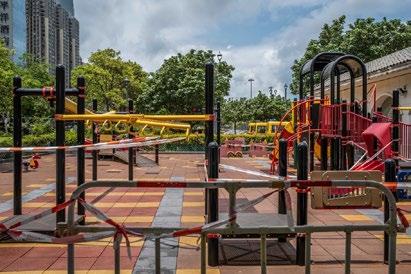
Throughout the semester, focus will be placed on connecting theoretical concepts with actual practices via close examination of international and local case studies. The ultimate purpose is to help students develop a critical lens for deciphering the complex forces that shape the built environment and the ethical challenges facing today’s design practitioners.

Is Play still a basic right during Covid?

Pang O Stilt Houses Typologies
Riverside one storey warehouses, ladder reaching from boat level, 1981
Metal Sheet Walls, Corrugated Metal Roofs, Giam Wooden stilts
Evolved from the “Sampan” - a traditional Southern China fishing boat
Evolved from the “Sampan” boat style Wooden boat panel mainly influenced the built of the stilt houses
Instructors : CHAN Yin-Lun XIAO Han Pat Teaching assistant LIN Yiling
“What is the Future of Conserving Hong Kong’s Coastal Vernacular Landscape? The changing environment and its impacts on the Tai O indigenous villages” by LIN Heimen Vanessa, and "Play as a Basic Right The possibility of inclusive playground in Hong Kong” by CHAN Chi Yin Kurt ARCH 7159 / 3103 (BA(LS)) / 2203 (BA(LS)) / Environment, Community, and Design
Change
Practice The University of Hong Kong Division of Landscape Architecture Annual 2020-21 112 113 香港大學園境建築學部設計年鑑 2020-21 Postgraduate Diploma in Landscape Architecture (PDLA)
Environment and Communities of the City Agency of
and Ethics of
Projecting Landscape Imagination
Landscape is not a genre of art but a medium ... of exchange between the human and the natural, the self and the other.
— William. J. T. Mitchell, Imperial Landscape in Landscape and Power
Robin Evans once claimed that architects don’t make buildings but representations of it. This course aimed to critically introduce and explore the media of landscape and representation skills like drawing and fabrication. We do not simply treat drawing forms as the media of landscape imagination, but carefully examine the media of landscape, the media of drawing, and the intervals between them. The drawing in landscape architecture, as James Corner described, can be “a plot, necessarily strategic, maplike, and acted upon in essence.” We think of drawing landscape as a process which let us to experience and express what we see and conceive, and moreover, to speculate and construct in the physical space.
The course focused on forms of drawing as an essential set of techniques for documenting, analysing and generating ideas. We introduced a series of techniques weekly based on the categorized media of drawing and fabrication, to communicate the media of landscape. The course works required engagement with drawing grammar (perspective, orthographic projection), denotative interpretation (notation, diagram), material expression (collage, mapping), and narrative construction (montage, animation). Particular attention was paid to understanding the complex mechanism in the dynamic, projective, and dialectical constructed network of design, media, and imagination.

ARCH 7181 / Landscape Media I
Instructor : XIAO Han Pat
Collaborative model 115 The University of Hong Kong Division of Landscape Architecture Annual 2020-21 香港大學園境建築學部設計年鑑 2020-21 Postgraduate Diploma in Landscape Architecture (PDLA)
The Fabrication of Terrain

This course introduced students to essential digital and manual tools of design and representation in landscape architecture. Students explored techniques in material testing and digital fabrication as an iterative part of the design process with digital platforms and procedural tools as key elements of a cross-media approach to digital production. Shifting from material analysis to visual programming and 1 to 1 fabrication, the course covered a variety of scales and modes. Three projects transformed the products of material observations into design methodologies and created an understanding of abstraction, rigor, and transformation through experimentation.
The first project, ‘Material Diaries’ focused on material experimentations. Students analyzed and compared materials theoretically and physically. The hands-on testing gave students a sensitivity for designing with a range of materials and relevant production processes. The second project ‘Shaping Material & Terrain’ focused on parametric 3D modelling and digital fabrication technologies. It created familiarity with technologies of computational design and handle a range of tools for digital fabrication available within the faculty.
Drawing inspiration from these two assignments, students developed in the final project a one-person seat or shelter. Material testing and tools of digital site analysis were ongoingly explored to help shape the device. Students worked with a combination of digital and analogue fabrication techniques; drawings, mock-ups, and a 1:1 prototype to communicate and test their design.
Instructors : CHUNG Harvey TRUMPF Susanne
Teaching assistant CHAN Syl Yeng Michelle

7182 / Landscape Media II
ARCH
Brick waterjet experiment by CHAN Ching Yin Kurt
117 116 The University of Hong Kong Division of Landscape Architecture Annual 2020-21 香港大學園境建築學部設計年鑑 2020-21 Postgraduate Diploma in Landscape Architecture (PDLA)
Plastic terrazzo with recycled PET and HDPE by LAU Fong Yui Yvonne
Landscape Architecture
Intensive
Instructors : ECHEVERRI Natalia WILSON Barry
Teaching assistants : NG Daisy SO Pearl
The PDLA Landscape Architecture Intensive is a three-week summer course developed to introduce students to concepts of landscape architecture within the context of Hong Kong. Daily sessions included lectures and workshops built upon basic drawing and representation techniques along with seminars introducing concepts related to scale, climate, materials and landscape design elements.
During the three weeks students were guided through an intensive design exploration that introduced them to representation technics, landscape architecture concepts and elements found within the small urban spaces of Hong Kong. For the first two weeks, students explored standard and non-standard units of measurement to survey and map a tree taken from the Register of Old and Valuable Trees list. They created a set of accurate measured documents of the tree using both plan and section / elevation and a series of illustrative diagrams that reveal information concerning the specific characteristics of the species, habitat and natural form. Using multimedia collage, they then explored the environmental context of the tree as it related to time, place and landscape systems. During the third week of the course, students explored fundamental conventions of landscape design through a series of incremental exercises that included essential skills of photographic mapping, collage, interpretation of image into drawing, and then drawing into model.



7191
ARCH
119 The University of Hong Kong Division of Landscape Architecture Annual 2020-21 香港大學園境建築學部設計年鑑 2020-21 Postgraduate Diploma in Landscape Architecture (PDLA)
Model by MAN Ting Yan Natalie Model by CHAN Ching Yin Kurt Mapping a tree by CHUNG How Yu

PDLA field trip to Pinewood Battery
Bachelor of Arts in Landscape Studies BA(LS) 園境學
文學士課程 122 The University of Hong Kong Division of Landscape Architecture Annual 2020-21 香港大學園境建築學部設計年鑑 2020-21
ARCH
Studio Laos
Strategic Landscape Planning for the Greater Mekong
Instructors : KELLY Ashley Scott LU Xiaoxuan
Teaching assistant
JIANG Xinjie
Strategic Landscape Planning for the Greater Mekong builds on seven years of designbased experiential learning across mainland Southeast Asia by the Division of Landscape Architecture. This year, focusing on the regional impacts of China’s Belt and Road Initiative in northern Laos, students spent one term engaging with issues of development vis-à-vis landscape architecture in order to define problems and produce innovative planning proposals. To build their knowledge base, students synthesized, through maps and diagrams, the geography and anthropology literature on Laos’s major drivers of landscape change. Having not visited Laos this term due to the pandemic, we took the opportunity to reinforce critical approaches to planning, in which we understand our ‘sites’ as inherently multi-sited constructs, dominated by different stakeholders’ perspectives. In place of their field trip, each student was assigned pairs of existing development projects that we had visited in previous years, and they were instructed to imagine the frictions between those sites’ ideologies, aims, expertise, and longer histories. For their strategic planning proposals, students asked difficult questions of both development and sustainability practices, including: challenging impact assessment scope; qualifying the remediation potential of Chinese contract farming; bridging scientific study and community forestry; mitigating the industrialization and over-harvesting of species for traditional medicine; and exploring overlaps between mass ecotourism, protected areas, and the illegal wildlife trade. Students had their work juried by a mix of ecologists, sociologists, geographers, activists, and philanthropists, in addition to designers and planners.


4704 / Landscape Design Studio V
“Bear Bile and Green Tape : Slow strategies for securing Luang Prabang's endangered socio-natures” by CHEANG Yuk Ching and MOK King Hei 125 The University of Hong Kong Division of Landscape Architecture Annual 2020-21 124 香港大學園境建築學部設計年鑑 2020-21 Bachelor of Arts in Landscape Studies (BA(LS))
The
ARCH 4704 / Landscape Design Studio V
Studio Laos
Strategic Landscape Planning for the Greater Mekong
Bachelor of Arts in Landscape Studies (BA(LS))



1. “Ethno-botanical Endangerment Preventing over-exploitation during the industrialization of Laos's medicinal plant species” by LEUNG Chun Fai Anson
2. “Ground Truthing Compensation : A livelihood-based landscape impact assessment for Namtha basin” by FONG Joyce


1. 2.
of Landscape Architecture Annual 2020-21 126 127
2020-21
University of Hong Kong Division
香港大學園境建築學部設計年鑑
4. “Extinction Landscape : Cultivation public awareness of the global wildlife trade at the Laos-China border” by ZHAI Qifei Frances The
Bachelor of Arts in Landscape Studies (BA(LS))
ARCH 4704 / Landscape Design Studio V
Studio Laos
Strategic Landscape Planning for the Greater Mekong


3. “Unfixing the Forest : A Planting plan for maintaining village land stewardship at the Laos-China border” by TO Cheuk Hei Agnes


3.
4.
University of Hong Kong Division of Landscape Architecture Annual 2020-21 128 129
2020-21
香港大學園境建築學部設計年鑑
Telephones and Birds
The studio works as a design primer, and as such, it introduces students for the first time to the elements and principles of design. Small scale objects and the spatial relations we establish with them formed the basis of our work. Three projects were proposed.
The first exercise took students to explore familiar streets and their objects through the lens of a designer. Random walks inspired by the situationists’ derives were performed. Students represented their walks and chosen objects or situations through diagrams, photography, and drawing.
The second exercise took students to play with origami-like structures. Following a set of given constraints, they transformed a piece of cardboard into a three-dimensional object; an object with no assigned use. The resulting useless object was then transformed by linking it to a function borrowed from one of the objects found in their previous walks.
Finally, students worked on a site-specific intervention. Taking Bernard Tschumi’s follies as a starting point, students proposed 12 structures to host a temporary aviary on the Peak. The project, called micro-follies, continued to explore matters such as human scale, movement, and perception in space.
Instructor : DELPON Andres
Teaching assistant CHAN Syl Yeng Michelle
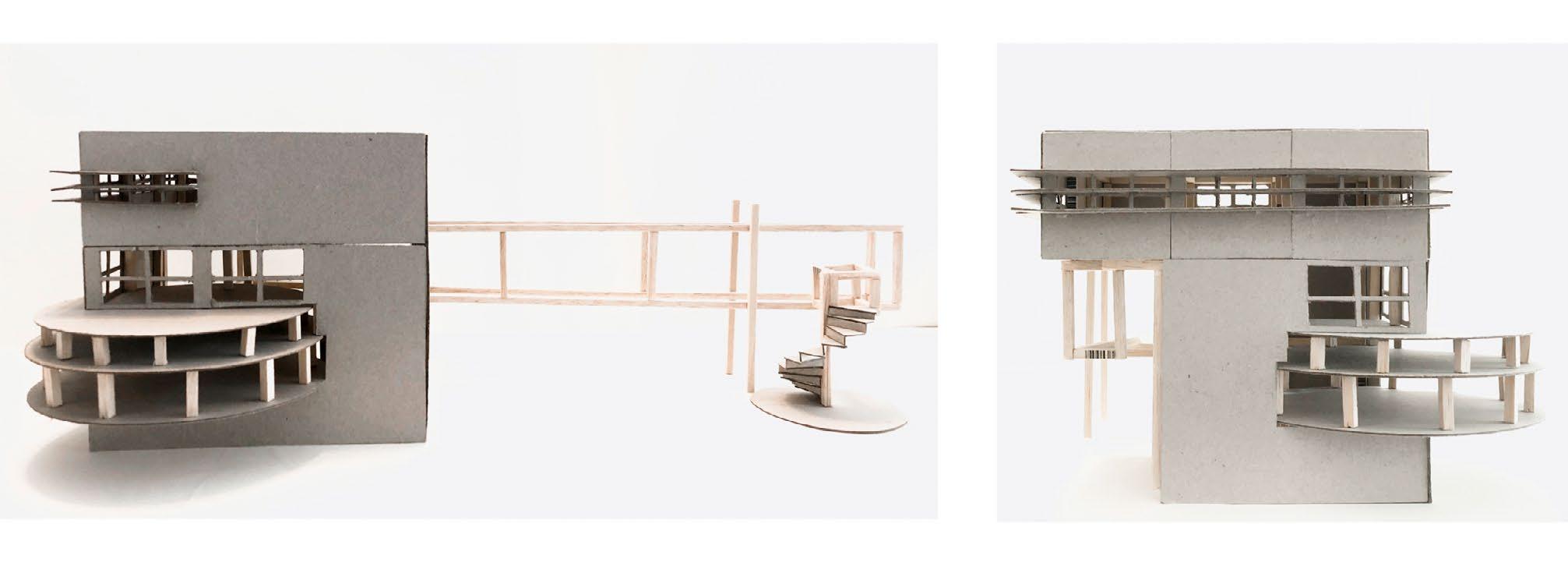 ARCH 1100 / Landscape Design Studio IA
ARCH 1100 / Landscape Design Studio IA
The University of Hong Kong Division of Landscape Architecture Annual 2020-21 130 131 香港大學園境建築學部設計年鑑 2020-21 Bachelor of Arts in Landscape Studies (BA(LS))
Model by WONG Hei Yuet Anna








7. 6. 5. 4. ARCH 1100 / Landscape Design Studio IA Telephones and Birds 3. 2. 1. 1. Diagram by WONG Hei Yuet Anna 2. Model by CO Sam Wendell Chen 3. Models in public review 4. Hybrid object drawing by KUAN Pui Shan Kimmy 5. Process axonometric by LAI Man Ching Ruby 6. Vignettes by TSUI Tsz Shan Iris 7. Vignettes by LAW Lok Tung Vanessa The University of Hong Kong Division of Landscape Architecture Annual 2020-21 132 133 香港大學園境建築學部設計年鑑 2020-21 Bachelor of Arts in Landscape Studies (BA(LS))
Instructors : DELPON Andres MAK Vincci
Teaching assistant JIANG Xinjie
The studio had two main goals: to consolidate the basic design vocabulary (elements and principles of design) explored in Design Studio 1A; and to anchor the planting knowledge obtained in ARCH 2105 Plants and Design 1.
Students started the studio selecting a tree species to study and analyse. In addition to their recently acquired botanical knowledge, they developed a broader understanding of the tree informed by the artistic, social and cultural aspects that define it.
Students also looked into the physical features of the tree. They produced abstract drawings and models, gradually distilling into a spatial concept some of the characteristics that make the observed trees more distinctive.
After these considerations and formal explorations, students went on to develop the concept for a specific site in Hong Kong: Red Brick Hill. The brief asked them to imagine an open-air museum dedicated to showcase an indefinite number of specimens of their choice. Concepts combining previous formal abstractions and socio-cultural association were confronted with the temporal and spatial changing needs that resulted in ephemeral studies and growing scenarios.
The open-air museums seen here provide a valuable catalogue, not only of trees, but of landscape designers’ dilemmas and the attitudes and tools at play to solve them.
 ARCH 2201 / Landscape Design Studio IB Tree Museum
ARCH 2201 / Landscape Design Studio IB Tree Museum
Perspective by LAI Man Ki 135 The University of Hong Kong Division of Landscape Architecture Annual 2020-21 134 香港大學園境建築學部設計年鑑 2020-21 Bachelor of Arts in Landscape Studies (BA(LS))
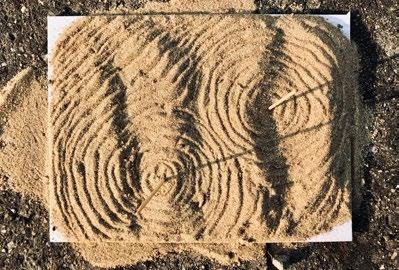

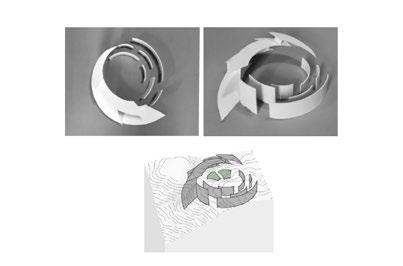





1. 3. 2. 4. 6. 7. ARCH 2201 / Landscape Design Studio IB Tree Museum 5. 1–2. Concept development by LI Huitong 3. Concept development and progress diagram by LI Ziyuan
Perspective by LI Ziyuan
Abstract model by WONG Lok Lam Joyce
General layout plan by KWONG Wai Yan
Sections by LI Huitong The University of Hong Kong Division of Landscape Architecture Annual 2020-21 136 137 香港大學園境建築學部設計年鑑 2020-21 Bachelor of Arts in Landscape Studies (BA(LS))
4.
5.
6.
7.
Constructing Landscapes
Instructors : ECHEVERRI Natalia ETTEL Nikolas
Teaching assistant JIANG Xinjie
The relationship between the representation of landscapes and the production of landscapes are integral. Drawings, models, or other types of representational tools offer possibilities in understanding the landscape in different ways and are a critical part of the design process rather than simply a presentation tool. In this studio, we shifted between drawings and models, experimenting with an iterative and cyclical process of documentation and speculation. Students used established means of representation to develop a composite and complex understanding of the landscape.
The studio examined the relationships between people and the natural and built environment. Through a series of exercises, students developed their skills in landscape architectural representation; identified and analysed key aspects that shape a site context; developed a vocabulary to build landscape experiences and proposed appropriate interventions in natural and developed contexts.
The final design exercise was sited on the Jubilee Battery, an area rich in history and subtropical ecology in Hong Kong Island. Remnants of Hong Kong’s coastal defence batteries are juxtaposed with a newly constructed educational facility, bringing a diverse set of users to the site. Students explored a dynamic palimpsest of the site which led them to the design of a path and a sequence of outdoor spaces.
 ARCH 2202 / Landscape Design Studio II (2019 Cohort)
ARCH 2202 / Landscape Design Studio II (2019 Cohort)
Final design by LI Ziyuan The University of Hong Kong Division of Landscape Architecture Annual 2020-21 138 139 香港大學園境建築學部設計年鑑 2020-21 Bachelor of Arts in Landscape Studies (BA(LS))




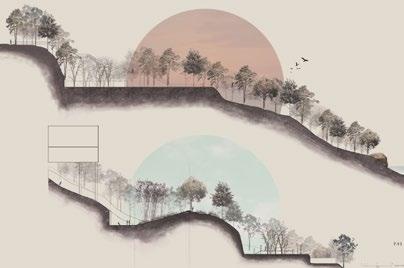


1. 6. 5. 3. 4.
Landscapes 2.
ARCH 2201 / Landscape Design Studio II (2019 Cohort) Constructing
Maisy
1. Final tectonic model by LAI Man Ki
Yan Kitty
2. Drawings of tectonic model by LEUNG Wing
Lydia
3. Design sketches by LI Huitong
Yan Kitty
4. Plan and sections by LEUNG Wing
Ziyuan
Ki Maisy The University of Hong Kong Division of Landscape Architecture Annual 2020-21 140 141 香港大學園境建築學部設計年鑑 2020-21
5. Model by LI
6. Section by LAI Man
Bachelor of Arts in Landscape Studies (BA(LS))
ARCH 3111 / Landscape Design Studio II (2018 Cohort) "... by nature"
‘Landscape’, can be understood as a dynamic assembly of natural systems in continuous interaction with human systems, operating at multiple scales (from site to territory) and across different time periods. Landscape planners, designers and managers need to be able to recognize these systems, their interrelationships and the forces behind them, so that they can anticipate change and develop responses that generate resilient outcomes.
In this studio we explored the landscape systems of the Port Shelter Area of Sai Kung, and saw how the form of urban development has responded to the natural, e.g. how the surface water drainage system is based on the natural hydrological pattern; how the design of the sea wall responds to tidal actions and storm events; and how the form and orientation of the buildings takes account of patterns of sunlight and seasonal winds. From this we developed a series of management and design strategies for varied sites around the Inner Port Shelter that were responsive to anticipated environmental and societal changes.
The studio helps develop foundational skills in ‘reading’ landscapes and ultimately for assessing their specific qualities and functions, as well as reflecting on the language of landscape architecture. Through selected landscape case-studies, readings, and technical exercises, we examined theories that underpin our ideas of landscape, and explored relationships between the built and the natural, at multiple scales and across time.
Instructors : PRYOR Mathew NG Sylvia
Teaching assistant CHAN Naomi
Design intervention by WONG Hon Ting Bryan

142 143 The University of Hong Kong Division of Landscape Architecture Annual 2020-21 香港大學園境建築學部設計年鑑 2020-21 Bachelor of Arts in Landscape Studies (BA(LS))
ARCH 3111 / Landscape Design Studio II (Cohort 2018) "... by nature"
Bachelor of Arts in Landscape Studies (BA(LS))


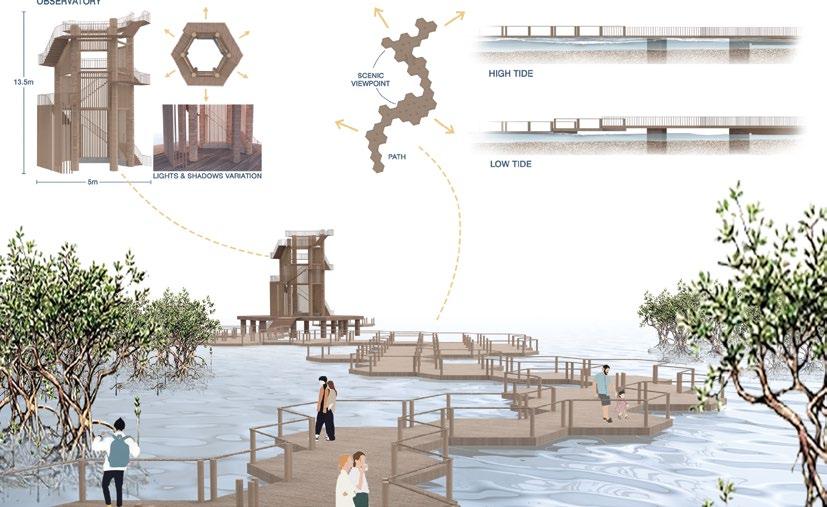
1. Design intervention by CHEUNG Tsz Yui Edelweiss
2. Design intervention by WONG Hoi Lam Michelle
3. Understanding the salt pan revitalisation project on Yim Tin Tsai
4. Exploring abandoned villages around Sai Kung District


3. 2.
4.
University of Hong Kong Division of Landscape Architecture Annual 2020-21 144 145
2020-21
The
香港大學園境建築學部設計年鑑
In Between the Collective and the Individual Co-designing with Multiple Communities in Shek Kip Mei
XIAO Han Pat
Teaching assistant
CHAN Syl Yeng Michelle
The fourth BA(LS) design studio intends to introduce students to the core concepts of community design through research, dialogue, and design production. As an introduction to community design methods, the design process emphasizes the necessity to understand the complex and dynamic nature of communities; the development of empathy and trust; the application of appropriate tools and sensitive approaches to design together with the stakeholders and create designs that cater to the different needs of the many different parties involved; and finally, the consideration of programme and the different types of boundaries and gradual transitions between varying degrees of publicness among different community spaces.
The principles of community design will be applied to the Shek Kip Mei area, which is the first public housing neighbourhood in Hong Kong. Over the years, the Shek Kip Mei Estate has been redeveloped several times since its first appearance as resettlement housing as an aftermath of the 1953 Shek Kip Mei fire. The study area of this studio covers the larger Shek Kip Mei area roughly defined by Tai Po Road, Cornwall Street, Nam Shan Estate, and the Tai Hang Tung Estate (refer to Studio Map). The area is defined by two hills, a general topography that slopes up towards the northern direction and characterised by a predominantly public housing landscape that is situated between the private developments of Shum Shui Po and Kowloon Tong.

ARCH 3112 / Landscape Design Studio III
Instructors : CHAN Yin-Lun
“ Shek Kip Mei 2040” by WONG Hon Ting Bryan 147 The University of Hong Kong Division of Landscape Architecture Annual 2020-21 146 香港大學園境建築學部設計年鑑 2020-21 Bachelor of Arts in Landscape Studies (BA(LS))
The University of Hong Kong
Division of Landscape Architecture
Annual 2020-21
ARCH 3112 / Landscape Design Studio III
In Between the Collective and the Individual Co-designing with Multiple Communities in Shek Kip Mei


香港大學園境建築學部設計年鑑 2020-21
Bachelor of Arts in Landscape Studies (BA(LS))


1. Site analysis by WONG Hon Ting, CHUNG Won Seok, LEE Yin Ching, & CHUNG Sum Yuet
2. Case study by LEE Kai Chi, CHAN Cheuk Yin, CHAN Chun Yin, & MOK Kai Fung
3. Planning charette by Group 2
4. Site analysis by CHEUNG Tsz Yui Edelweiss, CHEUNG Man Huen Jodie, & LEUNG Yik Chung Baron
5. Site analysis by CHUNG Won Seok
6. Model by LEE Yin Ching Athena
7. “Harvesting community” by LAM Tsz Kiu



3. 2. 4. 5. 6. 7.
1.
148 149
Post-Industrial Waterfront
Research of Sustainable Planning
Strategies at Industrial Legacy Site
Instructors : WILSON Barry JUHRE Claudia
Teaching assistant CHAN Syl Yeng Michelle
Students were given the ‘wicked problem’ of identifying and trying to resolve the complex and conflicting issues of urban renewal at wide planning horizons in scale and time. The urban industrial waterfront site at Gin Drinkers Bay offered multiple difficulties associated with access, connectivity, identity, contamination and inefficient land use. In assessing the area from differing micro and macro perspectives, students were led though systematic techniques to help enable them to evaluate and filter out relevant and targeted project programming inputs through the generation of overarching project goals, sustainability objectives and detailed and localised implementation strategies.
Explorations included projecting complex urban scenarios forward with vision and flexibility, ranging from infrastructure and urban morphology to social and natural systems, the norms for which are anticipated to change dramatically through the future periods of implementation. Such approaches were developed for critical decision making at an urban scale, specifically highlighting the necessity for understanding policy, funding and recurrent cost implications over the short, medium and long terms as well as the resultant implications for landscape design.
Deliverables were presented through a variety of media including class presentations using time control techniques, individual and collaborative video documentary, and final submission of a Project Study Report accompanied by a promotional video.
See more on https://arch4701fall2020.hku.hk/.

ARCH 4701 / Landscape Design Studio IV
“A smart and resilient future” by LI Ho Lok Klaus The University of Hong Kong Division of Landscape Architecture Annual 2020-21 150 151 香港大學園境建築學部設計年鑑 2020-21 Bachelor of Arts in Landscape Studies (BA(LS))
香港大學園境建築學部設計年鑑 2020-21
Bachelor of Arts in Landscape Studies (BA(LS))
ARCH 4701 / Landscape Design Studio IV
Post-Industrial Waterfront
Research of Sustainable Planning Strategies at Industrial Legacy Site

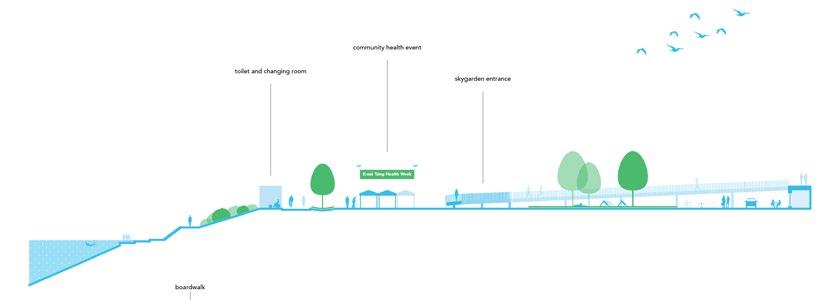
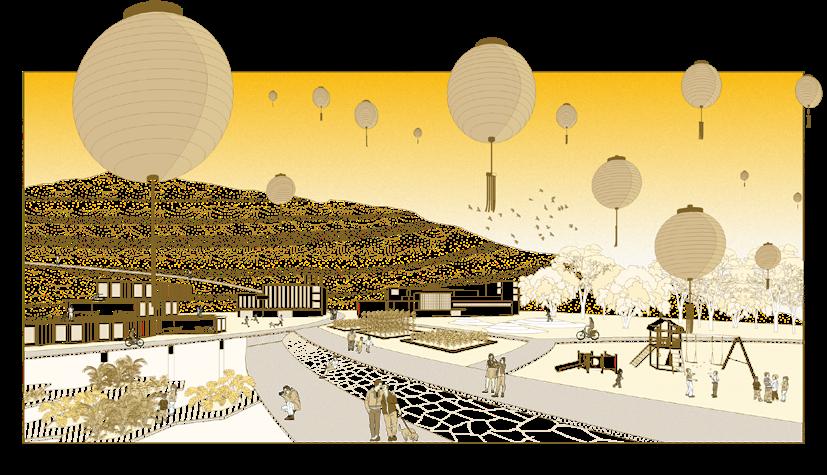
1. “Healthy Bay + : The first health and knowledge hub in Hong Kong” by LEUNG Chun Fai Anson
2. “Progressive Waterfront : Exploration of life cycles” by CHEANG Yuk Ching
3. “Kwai Chung Nostalgic Waterfront” by MOK King Hei
4. “LOOP : The leading scheme of a self-sustain and active smart destination” by FONG Joyce
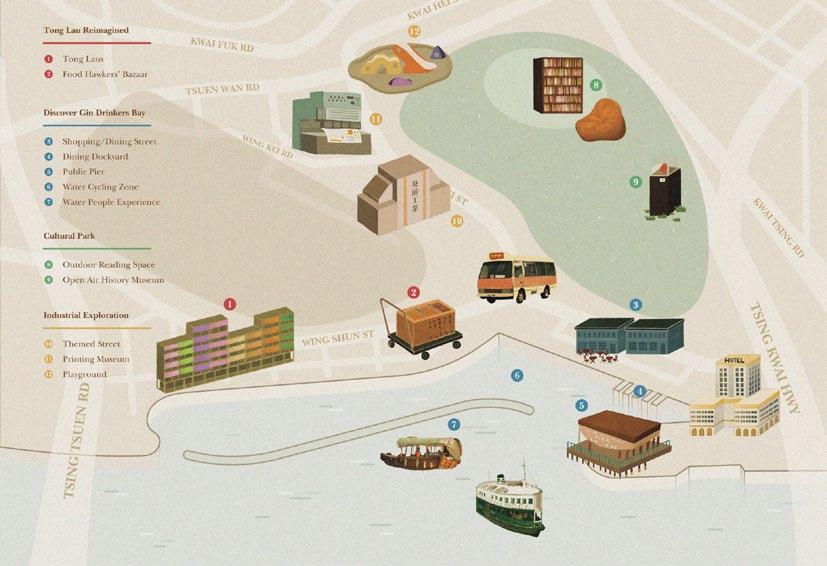

3. 1. 2. 4.
University of Hong Kong Division of Landscape Architecture Annual 2020-21 152 153
The
Landscape Intervention
As with any art or science, the successful practice of landscape architecture is dependent upon a comprehensive understanding of materials and their related technologies. In landscape it is possible to choose from a very broad spectrum of materials, from the natural to the artificial, from the inert to the organic, and then deploy them over a wide range of physical and temporal scales.
Technology in Landscape Architecture explores how components can be manipulated to form new landscapes, and how the processes of doing so can be a methodology for wider design understanding.
The course covers the key topics of landscape construction: grading; drainage; changing levels; forming roads; building walls and shelters; adding lighting and irrigation. Together they develop an understanding of the basic elements of the landscape and how they combine. Sessions involved lectures, followed by a related series of in-class exercises and assignments. Coursework comprised both the completed in-class exercises, together with further class research, case studies and explorations based on an application of the techniques.


ARCH 3102 / Technology in Landscape Architecture
Instructor : WILSON Barry
Designing a new set of steps by CHEUNG Tsz Yui Edelweiss 155 The University of Hong Kong Division of Landscape Architecture Annual 2020-21 154 香港大學園境建築學部設計年鑑 2020-21 Bachelor of Arts in Landscape Studies (BA(LS))
Plants and Planting Design I
Instructor : COATES Gavin
Teaching assistant
CHAN Syl Yeng Michelle
Plants and Planting Design I approaches the role of planting in landscape design from two main areas of study, namely planting design and horticultural knowledge in the context of various habitat types.
The planting design component introduced the history, basic principles, vocabulary, and process of planting design, along with the aesthetic, functional, and ecological characteristics of plants, how they vary over time, and how the designer interacts with these processes. The horticultural component provided an introduction to plant anatomy and physiology, the interaction between plants and their surroundings, nursery production, planting specification and maintenance.
Students were expected to familiarize themselves with a basic palette of commonly found plant species, representing a wide range of urban and rural habitats in Hong Kong. The Plant Reference Assignment required students to go out into the field, record plants, post photographs and other information on a dedicated course Facebook Workplace site. This arrangement allowed students outside Hong Kong to engage with the assignment, introducing plants typical of their locations elsewhere in China and Asia.
Field trips were a mainstay of this course, providing a multitude of real-life situations where the reciprocity between horticultural knowledge and design intent, and the long-term successes and failures of planting designs, could be observed and discussed on site. Field trips were livestreamed or recorded by video for the benefit of students outside Hong Kong. A series of quizzes associated with the field trips aimed to foster the habits of continuous observation and learning about plants.

ARCH 2105
Plan by LEUNG Wing Yan Kitty The University of Hong Kong Division of Landscape Architecture Annual 2020-21 156 157 香港大學園境建築學部設計年鑑 2020-21 Bachelor of Arts in Landscape Studies (BA(LS))
Ecology and Sustainability
Instructor : LEVEN Elizabeth
Teaching assistant JIANG Xinjie
This course seeks to enable students to develop an understanding of key ecological principles and the concept of sustainability and to appreciate the manner in which these principles underpin successful landscape design. Students were encouraged to investigate how the concepts of succession, biodiversity, habitat structure, plant communities and ecosystem stability contribute to the success (or failure) of urban landscapes, habitat creation projects and restoration of degraded landscapes and are, therefore, an essential tool in successful landscape design.
The course introduced the fundamental principles of ecology and sustainability by means of on-line lectures, quizzes and assignments. Unfortunately, due to the social distancing restrictions in response to Covid-19 pandemic it was not possible to undertake any site visits with the students. Instead, virtual, livestreamed and recorded site visits to local woodlands, an urban park and wetland habitat under construction highlighted the practical implications of the concepts presented. Students were required to analyse ecological aspects of existing landscapes, compare two different woodland ecosystems within Hong Kong and undertake an assessment of an existing landscape in terms of its sustainability.

ARCH 4706
Bachelor of Arts in Landscape Studies (BA(LS)) “Infrastructure and soil quality in Tai Tong East Borrow Area” by CHEANG Yuk Ching and MOK King Hei The University of Hong Kong Division of Landscape Architecture Annual 2020-21 158 159 香港大學園境建築學部設計年鑑 2020-21
Landscape and Design in China
Instructor : JIANG Bin
Teaching assistant YANG Yuwen
This course undertook a critical evaluation of landscape and design in contemporary China and the socioeconomic, cultural, and political forces that have impacted the landscape, including architecture, landscape architecture, urban design, planning, and infrastructure, which have formed the landscape of China today. Students explored important landscape issues and phenomena in detail and depth under the context of urbanization and globalization in China. Topics covered in this class include the regeneration of various type of urban public spaces, the emergence of the ecological crisis and ecological design, children and senior-friendly landscapes, contemporary landscape and art, landscape and social justice, shrinking cities, philosophies for idea landscape, and oversea landscape architects in China. The course consisted of lectures, student presentations, reading discussions. Assignments included 2 group presentations, 3 quizzes, an individual essay, and illustrations on a selected topic. These assignments helped students understand how scholars and designers ask questions, make findings, and discuss their findings. It also provided an opportunity for students to study a particular research object in-depth and strengthen their understanding of the multiple dynamics that shaped the landscape issue. Lastly, it allows students to articulate the ideas, evidence, and cases covered in the course.



ARCH 4703
“Social repositioning of Chinese middle-to-old aged women facilitated by square dancing” by CHEANG Yuk Ching, FONG Joyce, & TO Cheuk Hei The University of Hong Kong Division of Landscape Architecture Annual 2020-21 160 161 香港大學園境建築學部設計年鑑 2020-21 Bachelor of Arts in Landscape Studies (BA(LS))
ARCH 1029
Introduction to Landscapes
A Disciplinary Exploration
This course consisted of a guided tour through a series of approaches, understandings, and definitions of landscapes that resonate with the work of landscape architects across places and time. The objective was to navigate the many histories — from the formation of cities and the multiple interpretations of nature, to ethnographic explorations around the world — which contribute to the practice of landscape architecture today and in the past, but also engage with what it could become in the future. History was explored in its disciplinary and cultural diversity and understood as a way to construct alternative futures. History is embedded in the present as it is constantly re-examined and re-written through evolving concerns, debates, and questions that demand new knowledge, new approaches, new narratives.
Weekly lectures followed a thematic rather than chronological order, ranging from the history of the profession of landscape architecture and its early formation, to the most challenging and alternative understandings of the experience of landscape in disciplines seemingly unrelated. Students engaged critically with definitions of landscape from art, geography, science, archaeology and anthropology, through selected representative case studies. They became familiar with a wide range of approaches to landscape and develop intellectual positioning through argumentations and debates.
Instructor : DECAUDIN Maxime
Teaching assistant CHAN Syl Yeng Michelle

163 162 The University of Hong Kong Division of Landscape Architecture Annual 2020-21 香港大學園境建築學部設計年鑑 2020-21 Bachelor
CHUNG Pui Shan, CO Sam Wendell Chen, LAM Yi Ham, LEUNG Hoi Ting, & WONG Hiu Man showing to their classmates how landscapes are depicted in films
of Arts in Landscape Studies (BA(LS))
Forms and Methods
This course is designed to foster habits of accurate and disciplined observation, as well as imaginary flair, and to introduce students to a range of hand-drawn illustration skills and techniques that they can draw on throughout their careers.
The first of three sections, ‘Illustrating Landscapes,’ focused on the highly detailed representation of a 350mm square area of ground at 1:1 scale, followed by abstract interpretations of the same area. The process was then reversed, and students were asked to produce abstract ‘blots,’ then to reinterpret these as imaginary, figurative landscape drawings.
The second section, ‘Projecting Landscapes,’ required students to make a three-dimensional model of an imaginary landscape, which was then represented using contour drawings and sections. This was followed by perspective drawing techniques, where students produced perspectives of buildings on campus and these were then reinterpreted as collages.
In the third section, ‘Dynamic Landscapes,’ students were introduced to life drawing of the human body, and still life drawing of plants, trees and vegetation. Finally, the life drawing, vegetation drawing, perspectives and other illustration skills were fused in ‘before’ and ‘after’ renderings of street scenes. Students drew the streets in their existing state and then reimagined them as pedestrianized precincts with street furniture, pedestrians and trees.



1031 / Landscape Representation I
ARCH
Instructor : COATES Gavin
Teaching assistant CHAN Syl Yeng Michelle
Before and after drawings by TSUI Tsz Shan Iris Material drawing by WONG Hei Yuet Anna 165 The University of Hong Kong Division of Landscape Architecture Annual 2020-21 香港大學園境建築學部設計年鑑 2020-21 Bachelor of Arts in Landscape Studies (BA(LS))
Systems and Simulations
Instructor : KELLY Ashley Scott
Teaching assistants : XIAO Han Pat JIANG Xinjie
Landscape Representation 2: Systems and Simulations offered a landscape-centric approach to digital analysis and representation. While sharing histories and methods with architecture and planning, landscape representation — given its engagement with natural processes and ecologies — requires greater control over complex forms and materials. This course established students’ foundational knowledge in computer science and geographic information systems (GIS) through reviewing innovations, vocabularies, and impacts of disruptive technologies on design and project delivery since the 1960s. While these histories help form a critical understanding of software as a medium of design, this course also questioned the inherent problems of landscape as a digital and narrative medium. Students manipulated geospatial data from remotely sensed and open-source datasets to build a generalist’s understanding of geospatial digital media for the range of scales that landscape architects confront and in which they collaborate. Automation and iterative, procedural workflows were stressed as part of an efficient design process and problem-solving toolset for landscape research and design, from regional to site-scale works. For their term projects, students applied GIS and parametric modeling tools to explore landscape and biodiversity modeling techniques for measuring connectivity, fragmentation, species richness, and environmental impact with a focus on describing issues of data quality, scientific bias, reductive methodologies, and disciplinary blindspots in landscape ecology.



ARCH 3097 / Landscape Representation II
Comparison of landslide susceptibility models in Lantau by HO Dai Rong Heather, LIU Jiani Vicki, & ZHANG Jenifer Least cost path (LCP) explorations of habitat connectivity across ecological scales in Kowloon by CHEUNG Man Huen Jodie, CHEUNG Tsz Yui Edelweiss, & LEUNG Yik Chun 167 The University of Hong Kong Division of Landscape Architecture Annual 2020-21 香港大學園境建築學部設計年鑑 2020-21
Bachelor of Arts in Landscape Studies (BA(LS))
Material, Computation, Fabrication
New construction technology has changed the way we shape our cities. Landscape architects, architects and designers should consider digital fabrication technology as a tool, a process that empowers design by taking advantage of its speed, scalability and cost efficiency. In order to revolutionize the way we build, designers must not only understand the limitations of the tools, but also have a deep knowledge of materials and associated properties. Latest advancement of computer softwares, machine robotics and material science has led to a new world of construction possibilities.
In spring semester 2021, students were asked to explore ways of deploying these inventions in architecture and landscape design. We have looked into materials, fabrication technology and computational design as a holistic discourse.
Starting with the notion of material driven design, students began the course in researching everyday life materials that have potential in creating new experiences in built environments. After coming up with a material concept for a design, students then went through a series of computational design tutorials using grasshopper to explore ways to create forms parametrically. They have also experimented with environmental analytic tools in grasshopper where they can bring a different perspective to justify their design concept and site positioning strategies. With the special arrangements in this semester, students not in Hong Kong were asked to focus more on digital representation such as photo realistic renderings and detailed fabrication drawings. Students in Hong Kong will be working in groups to produce digitally fabricated physical outputs.


ARCH 3098 / Landscape Representation IV
Bookshelf fabrication process by CHEUNG Tsz Yui Edelweiss, LEE Kai Chi Adam, CHEUNG Man Huen Jodie, & LEUNG Yik Chun Baron
Instructor : CHUNG Harvey Teaching assistant CEVALLOS BARRAGAN Francisco
Fabrication diagram of hydroponic farm by HO Dai Rong Heather, LIU Jiani, SZETO Hiu Ching, & WONG Hon Ting Bryan 169 The University of Hong Kong Division of Landscape Architecture Annual 2020-21 香港大學園境建築學部設計年鑑 2020-21 Bachelor of Arts in Landscape Studies (BA(LS))
AFIC 1001 / Faculty Interdisciplinary Course
Get Inspired!
Instructors :
ETTEL Nikolas
PRYOR Mathew
WEBSTER Chris
Teaching assistants :
CHAN Syl Yeng Michelle
CHAN Naomi
JIANG Xinjie
WANG Yadian
The Faculty Interdisciplinary Courses (FICs) are structured around collaborative thinking and offer a trans-disciplinary approach to learning. Designed and taught by teachers spanning all five departments, the FICs allow students to gain deep insights of faculty members’ teaching and research work, including HKUrbanLabs, and to engage with peers outside of their own discipline through course workshops, research projects and group-activities.
The courses offer a multi-disciplinary perspective of the built environment, this year through the lens of public health. Through collaborative projects, students will learn to become innovative team- players, equipped with creative problemsolving and communication skills. In addition, students will sharpen their awareness of the increasing inter-disciplinary nature of practice within the built environment and broaden their understanding of their responsibilities within an increasingly complex world. The goal is to develop shared interests and appreciation that help to form long-lasting, cross-disciplinary friendships for students’ future careers.
Part I AFIC1001 is a broad-based survey the built environment disciplines, exposing students to the broad theories, methods and key questions of the various disciplines within the Faculty of Architecture, and examining how each has sought to address the chronic challenges of public health in the city.
Co-curator Mr. Mathew Pryor (left) in conversation with Prof. Gray Kochhar-Lindgren (right), Director of the Common Core, HKU, at the exhibition

170 171 The University of Hong Kong Division of Landscape Architecture Annual 2020-21 香港大學園境建築學部設計年鑑 2020-21 Bachelor of Arts in Landscape Studies (BA(LS))
the Zero Carbon building was developed in 2012. Subsequently, a bus stop was built on the pedestrian road, which results in an isolated section.
Bachelor of Arts in Landscape Studies (BA(LS))
AFIC 1002 / Faculty Interdisciplinary Course
Reaching Out
Image Source: https://www.google.com/maps (2019)
Instructors : ETTEL Nikolas
PRYOR Mathew
WEBSTER Chris
Teaching assistants :
CHAN Syl Yeng Michelle
CHOI Cherry
JIANG Xinjie
WANG Yadian
The Faculty Interdisciplinary Courses (FICs) are structured around collaborative thinking and offer a trans-disciplinary approach to learning. Designed and taught by teachers spanning all five departments, the FICs allow students to gain deep insights of faculty members’ teaching and research work, including HKUrbanLabs, and to engage with peers outside of their own discipline through course workshops, research projects and group-activities.
Image Source: https://www.google.com/maps (2021)
The courses offer a multi-disciplinary perspective of the built environment, this year through the lens of public health. Through collaborative projects, students will learn to become innovative team- players, equipped with creative problemsolving and communication skills. In addition, students will sharpen their awareness of the increasing inter-disciplinary nature of practice within the built environment and broaden their understanding of their responsibilities within an increasingly complex world. The goal is to develop shared interests and appreciation that help to form long-lasting, cross-disciplinary friendships for students’ future careers.
Part II AFIC1002 challenge students to work in mixed disciplinary groups to explore the nature and value of the research work of the Faculty’s research Labs, and to develop a group project that takes knowledge / practices generated by one of the Labs and to investigate how it has been applied to a specific site.
, connected using tunnels, collectively forming a 19km shelter network together with the Kowloon located area. However, most shelters entrances and windows are closed and sealed. The King George V Memorial Park was originally built on Canton Road in 1936, but was relocated and rebuilt on top of the air-raid shelter in 1941.




67
Urban trivia by WONG Ho Wang Caleb, SO Chung Man, LEE Man Wai Monique, LEUNG Man Wan, & WAN Tsz Ho The University of Hong Kong Division of Landscape Architecture Annual 2020-21 172 173 香港大學園境建築學部設計年鑑 2020-21




“Beyond What We See: First Year Students interpreting the City” exhibition 175 The University of Hong Kong Division of Landscape Architecture Annual 2020-21 香港大學園境建築學部設計年鑑 2020-21
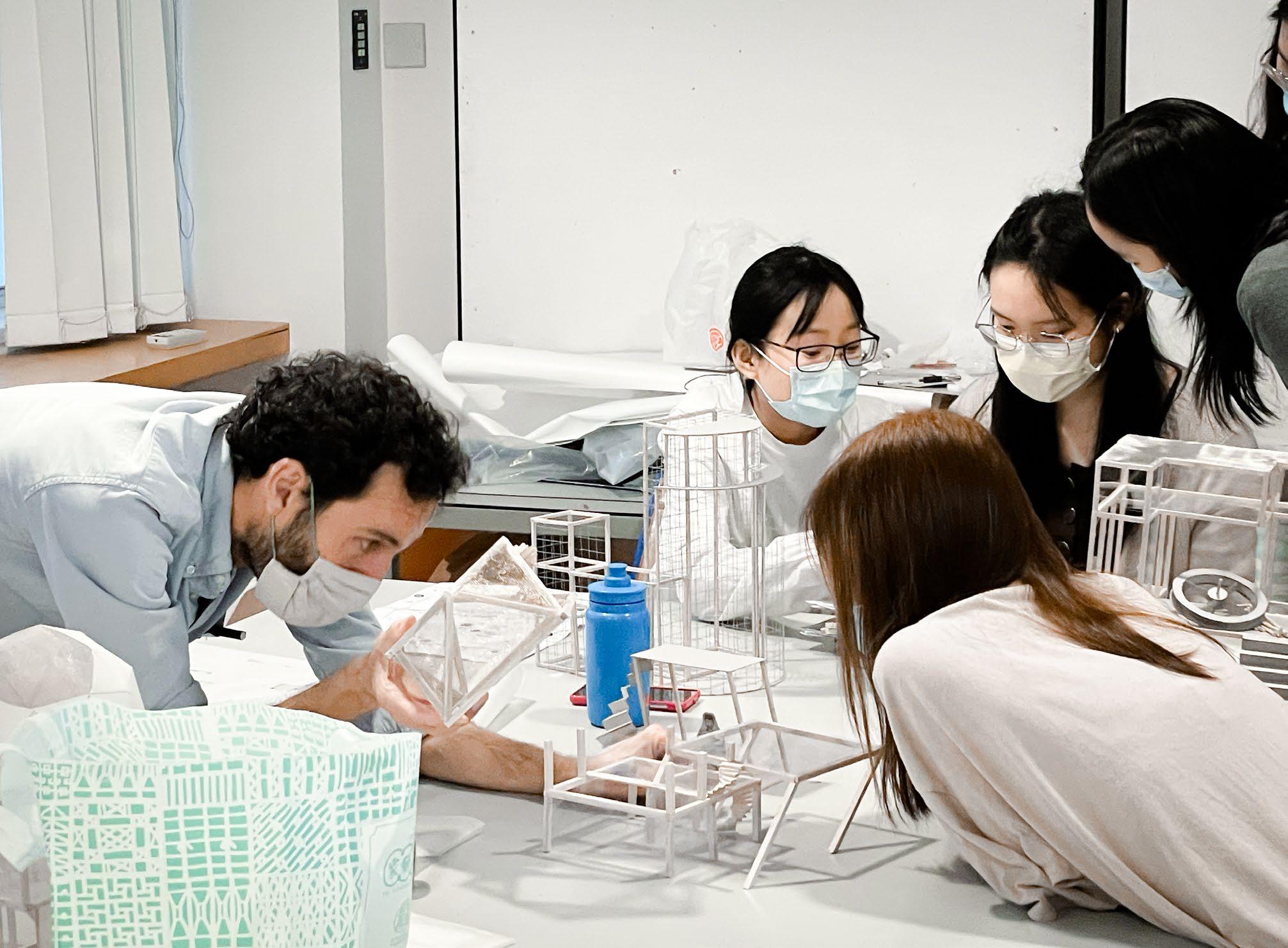
BA(LS) desk crit session
核心課程 178 The University of Hong Kong Division of Landscape Architecture Annual 2020-21 香港大學園境建築學部設計年鑑 2020-21
Common Core Curriculum
Designs on the Future
Sustainability of the Built Environment
Instructor : PRYOR Mathew
Teaching assistants :
CHAN Michelle Syl Yeng
CHOI Cherry
JIANG Xinjie
WANG Yadian
CCHU9001 is intended to inspire thinking about the way we should construct our living environments in future, in order to find the most sustainable balance. It explores the United Nation’s Sustainable Development Goals (SDGs) as they apply to Hong Kong, addressing issues of population and urbanization; materials resources; and human systems, in order to understand the concept of a ‘sustainable future. It also evaluates the different media and strategies that people have used / are using to advocate for more sustainable approaches to the environment and community.
This year the course was run entirely on line, and used, the award-winning Digital Exhibition Space, a specially designed virtual 3D environment within which student groups collaborate, present and evaluate their coursework. Students were assigned into mixed groups of 4 students, each working to develop and curate a gallery to present one of the SDGs. Students generated a wide range of artefacts for their gallery based on core coursework assignments (SDG video; infographic posters; mind maps, reading responses), together with a number of self-selected items (e.g. visitor quizzes, timelines, case studies). Finally, students had to visit and give feedback on other student galleries in the form of postcards; and write reflection on how the rooms related to the central idea of a sustainable community.


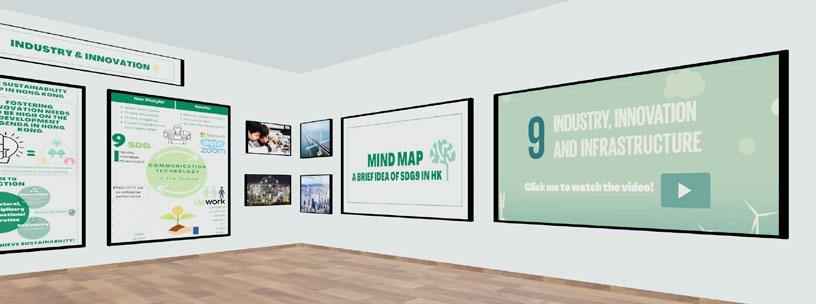

CCHU9001
Final gallery presentations in the Digital Exhibition Space 181 The University of Hong Kong Division of Landscape Architecture Annual 2020-21 180 香港大學園境建築學部設計年鑑 2020-21 Common Core Curriculum
CCHU9048
The City Histories of Urbanism and the Built Environment
What is a city? Through what processes is our built environment constituted? How do we dwell in our cities and how do different kinds of urban spaces shape our sense of place and community belonging? This course explores practices of urbanism across a range of contexts from antiquity to the present day. By doing so, it allows students to develop insights into the social relations and human struggles that have been produced by, and continue to produce, particular types of built forms in different places over time. In the broadest sense, the course uses urbanism as a lens to understand the relationship between urban forms and the complex, multiple processes that constitute cities and their urban milieus. The course content was organized around sets of case studies, with each focusing on a specific theme that indicates particular continuities and congruencies between cities of different locations and time periods. Discussion throughout the course engaged with questions related to contemporary urbanization and considered how historical knowledge may impart a better understanding of the challenges we are facing in the global present. Assignments of the course included a series of exercises that combined historical research with creative writing. The formats of these exercises vary from year to year. The goal is to enable students to connect the tangible and intangible aspects of cities and strengthen their textual, visual and presentation skills.
 Instructor : CHU Cecilia Louise Teaching assistants : WANG Yadian YAN Xiaoxu ZENG Wenxin
Instructor : CHU Cecilia Louise Teaching assistants : WANG Yadian YAN Xiaoxu ZENG Wenxin
182 183 The University of Hong Kong Division of Landscape Architecture Annual 2020-21 香港大學園境建築學部設計年鑑 2020-21 Postgraduate Diploma in Landscape Architecture (PDLA) Common Core Curriculum
A future urban history project
24 Frames
Communicating Ideas through Film
Films move at 24 images (or frames) per second, while the stories they convey emotionally move us. Either in the form of daily-shared stories on our phones or streaming platforms at home, motion pictures are deep-seated. This course investigates films as transformative tools for thought. Students will learn about interesting ways of watching films, film criticism, and especially how to communicate powerful ideas through short films. By the end of the semester, students will be able to translate their own ideas on screen by producing an individual short film that uses the method of remediation to visually discuss Hong Kong-related themes.
Driven by an international range of film productions across time periods and genres, we will begin to develop a visual vocabulary through terms such as mapping, observation, narrative and montage in order to create our own short film adaptations. Using a ‘procedural mode of engagement’ — which we will explain in class — as a way of examining these contexts and frames, the course adapts film- making as an act of creative engagement with the built environment. This creative reservoir of residential atmospheres helps us to question our current place and time. Through in-class discussions, critical film analysis, peer reviews, and final short film screenings, the course aims to present the various modes and styles of film production and further enhance students’ visual communication skills. No prior film or poster making skills are required.




CCHU9082
Instructor : ETTEL Nikolas
Teaching assistants : CHAN Syl Yeng Michelle CHAN Naomi JIANG Xinjie
Burst into flames by HU Zhongyu, LO Hei Yin, LUI Ching Ching, NG Song Fang Janine, & NGAI Hei Brian 185 The University of Hong Kong Division of Landscape Architecture Annual 2020-21 香港大學園境建築學部設計年鑑 2020-21 Common Core Curriculum
Nature in the City
Beyond the Concrete Jungle
This four-week Common Core Course focuses on our human relationship with nature as manifested in the fabric of the city around us. Firstly, we examined the history of this relationship, the spectrum between ‘artificial’ and ‘natural’, and natural laws such as interconnectivity. How do our cultural preconceptions, urban infrastructure, lifestyle and economics, compliment or flout those laws? Students produced a written opinion piece on ‘an example of nature in my home’, examining our attitudes to that chosen aspect, then extrapolating what this tells us about our relationship with nature generally. Secondly, we embarked on a critical review of the manifestations of nature in the city, asking why any given relationship is the way it is. Student groups produced short videos observing a particular aspect of nature in the city, highlighting our sometimescontradictory relationship with nature. Thirdly, students contextualized the insights gained from the previous sections into their own discipline, producing individual metaphorical posters featuring ‘The Tree of Something in The City of Something’ where the tree represents a topic of the student’s choice, and the city represents the context for that topic. 112 students enrolled in the course, of which 36 attended face to face and 76 online. Online teaching included a field trip live-streamed online, and the final gallery review of posters on a dedicated Digital Exhibition Gallery.


CCHU9058
Instructor : COATES Gavin
Teaching assistants : CHOI Cherry
FONG Joyce HUI Chun Sing
Exhibition of students’ metaphorical tree posters on the dedicated online Digital Exhibition Gallery Poster ‘The Tree of Dieting in the City of Abundance’ by HO Tsz Lam 187 The University of Hong Kong Division of Landscape Architecture Annual 2020-21 香港大學園境建築學部設計年鑑 2020-21 Common Core Curriculum
哲學碩士 /博士課程 188 The University of Hong Kong Division of Landscape Architecture Annual 2020-21 香港大學園境建築學部設計年鑑 2020-21
MPhil / PhD
MPhil / PhD Program
Currently housed under the Department of Architecture, the MPhil/ PhD Program in Landscape Architecture is intended for persons who wish to enter teaching and advanced research careers with a commitment to making an original contribution to the field.
Students carry out research under the supervision of faculty members in the Division of Landscape Architecture on a specific subject of enquiry. Research areas include, but are not limited to: built environment and urban landscape for public health and well-being; landscape and environmental planning, urban agriculture and green infrastructure, natural and cultural heritage conservation, and histories and theories of planning and urbanism.
The Program is connected to a number of research centers associated with the HKUrbanLab, the research arm of HKU’s Faculty of Architecture. The Program hosts a biannual Research Postgraduate Student conference and a CIB Student Chapter, which organizes international conferences at regular intervals. In addition, students also have opportunities to present their ongoing research work at monthly departmental Research Postgraduate Seminars as well as to participate in teaching activities.
Post-Consumption Space in Historic Urban Areas
This study looks into the governance and production process of urban historic areas in Guangzhou, more specifically, the power relationships, interests and aspirations of various actors redefining the value of these areas.
CHEN Xinhui
MLA, University of Virginia
Supervisor :
CHU Cecilia Louise
Improving urban neighbourhood green space for the health and well-being of the older adults to age-inplace
The research aims to investigate the relationship between neighbourhood green space and health among the aged, underlying urbanization and aging issues. It will expand the theoretical frameworks of current deficient studies by shifting the research emphasis from individual scale to neighbourhood context and bringing in multi-level thinking, while designing and evaluating the sustainable neighbourhood green space that support the healthy living until old age.
LI Jiali
MLA, Rhode Island School of Design
Supervisors :
JIANG Bin (Principal supervisor)
CHEN Bin (Co-supervisor)
190 191 The University of Hong Kong Division of Landscape Architecture Annual 2020-21 香港大學園境建築學部設計年鑑 2020-21
Making Remittance Houses in China
It is a study of rural-to-urban migrant workers agency through exploring the production of remittance houses in China.
LIN Yi-Ling
MS(NTU), MA, BA(Soochow U, Taiwan)
Nature as the Antidote: Examining the Impact of Urban Forest on Drug Addiction Rehabilitation
LUO Lan
MLA, Sichuan Agricultural University
Virtual nature as medicine: Exploring impacts of highly simulated nature on patients’ mental health at an orthopaedic rehabilitation hub in Hong Kong
Supervisors :
CHU Cecilia Louise
CHAN Roger
Three key objectives of this study are 1) to identify the acute and chronic impacts of nature intervention on the rehabilitation process; 2) to propose the promising mechanism and pathways of the nature environment for treating addiction;3) to provide practical suggestions for creating supportive environments for addicts.
Supervisors :
JIANG Bin (Principal supervisor)
JIA Beisi (Co-supervisor)
Landscape Framework for An Adaptive Urbanism in Chiang Mai, Thailand
LIU Xueming
MLA
The nature therapy based on the virtual reality technology has not been fully understood and not been well applied in health care institutions yet. This research will introduce VR therapy in the orthopaedic rehabilitation centre to provide orthopaedic patients with a variety of virtual natural therapy experiences.
Supervisors :
JIANG Bin (Principal supervisor)
SCHULDENFREI Eric (Co-supervisor)
LU Wilson (Co-supervisor)
This study investigates the landscape framework that bridges the gap between indigenous environmental philosophy and contemporary conservation practice to empower an adaptive urbanism in Chiang Mai, Thailand
SATTAYANURAK Kanisa
BArch (First Class Honors), Chiang Mai University; MLA, HKU
Supervisors :
LU Xiaoxuan
CHU Cecilia Louise
192 193 The University of Hong Kong Division of Landscape Architecture Annual 2020-21 香港大學園境建築學部設計年鑑 2020-21
Wetland Governance: Constructed Landscape and Modernity towards Ecological Civilization in Tai Lake Basin, China
WANG Ting
BA Urban Planning and design (First Class Honors), University of Liverpool; MLA, HKU
Income, Real Estate and Landscape Disparity: A Vicious Cycle of Immobilized Society
This study looks at the development process of contemporary wetland parks and the production of social meanings and values.
Supervisors :
CHU Cecilia Louise
SENG Eunice
LU Xiaoxuan
YANG Yuwen
MLA, University of Georgia
Biased land use planning and unequal allocation of public resources has caused environmental injustice in high density cities. This study aim to examine the associations among human-centric perspective environmental exposures, income, and real estate factors at TPU level in Asia high density city Hong Kong using semantic segmentation and deep learning algorithms.
Examining environmental impact on drivers’ mental & physiological health and performance in urban roads
XU Wenyan
MA, China University of Mining and Technology
This study will explore the relationship between road environments and drivers’ health and safety through the two main questions. (1) Whether and what environmental characteristics significantly affect mental status, physiological status and driving performance? (2) What environmental characteristics of roadside landscape can achieve satisfactory and optimal balance among these benefits?
Supervisors :
JIANG Bin (Principal supervisor)
WEBSTER Christopher John (Co-supervisor)
The Creative City? Industrial Reuse for Arts Development in Hong Kong
Supervisors :
JIANG Bin
XU Frank
ZENG Wenxin
MSc(Urban Design), HKU
This PhD dissertation aims to use arts development as a lens to unpack the economic and social transformation process in Hong Kong. It will explore how this creative city concept has been adapted under Hong Kong’s unique historical context, how the material aspects of arts space ties together with the mental and social aspects of spatial production through time, and how the adaptive re-use of old industrial buildings is related to the discourse of conservation.
Supervisors :
CHU Cecilia Louise
ZHOU Ying
194 195 The University of Hong Kong Division of Landscape Architecture Annual 2020-21 香港大學園境建築學部設計年鑑 2020-21
196 Staff List 教師名單
Associate Professor of Practice
JIANG Bin
REN Chao VALIN Ivan
LU Xiaoxuan
ECHEVERRI Natalia MAK Vincci
BEngUP Hunan; MSLA Peking; PhD Illinois
BArch; PhD; BEAM Pro
BSc(ARCH) Virginia; MLA + MArch UC Berkeley
Associate Professor CHU Cecilia Louise BAA Ryerson; MA PolyU; MSc HK; PhD UC Berkeley Assistant Professor KELLY Ashley Scott
BScArch Michigan; MArch Harvard
BArch SCI-Arc; MLA Harvard; PhD Peking
BA Washington; MCP, MArch UC Berkeley
BArch USC; MLA Harvard; SFHEA
JUHRE Claudia
KOKORA Michael
LEVEN Elizabeth
NG Sylvia
BA(Hons) Belgium; Grad Dip LA LMU; M(Sc) EUS BUW; MUP Tongji
BA Minnesota; MArch Yale
BSc MPhil Edinburgh; RLA; FHKILA
BSLA Penn State; MLA UC Berkeley; AA Dipl
WILSON Barry
DECAUDIN
BA(Hons) Heriot-Watt; CMLI; HKRLA; FHKILA; FHKIUD; CEDR accredited
DipESA(Paris); HMNOP
COATES Gavin
TRUMPF Susanne
CHAN Yin-Lun
ETTEL Nikolas
XIAO Han Pat
WANG Yadian CHAN Naomi Senior Lecturer Lecturer Assistant Lecturer Teaching Assistant
CEVALLOS BARRAGAN
Francisco CHAN Syl Yeng Michelle
JIANG Xinjie
BLA DipLA Leeds; DipPCDI; CMLI(UK); MCSD(UK); FHKILA; RLA; CA; FHEA
BArch TU Berlin; MArch TU Delft; FHEA
BASc(Hons), BES(Hons) Waterloo; MLA UBC; PhD HKU; ASLA; HKILA; RLA(HK)
BArch AkBild; ir.Arch MA(AH) Bartlett, UCL
BEng HUST; MLA HK
BArch Spain; MLA HK
BA(LS) HK
BA(LS) HK
BA(LS) HK
BLA BFU; MLA HK
Full-time Staff Title Name Qualifications/ Affiliations Head of Division Associate Professor (Teaching) PRYOR Mathew BA(Hons) Heriot-Watt; CMLI; RLA; FHKILA; SFHEA Senior Lecturer Program Director (PDLA / MLA) Senior Lecturer Program Director (BA(LS))
Title Name Qualifications/ Affiliations
Assistant Professor Lecturer CHUNG Harvey BSArch Michigan; MArch Yale
Spain; RIBA
Maxime Part-time Staff
Adjunct
DELPON Andres MArch, MEd(PGCE)
ROBINSON Ian CHort; MCIHort; ISA; TRAQ; HKILA ArbP
198 199 The University of Hong Kong Division of Landscape Architecture Annual 2020-21 香港大學園境建築學部設計年鑑 2020-21

Review guests in MLA thesis review
Chinese Translation CHEN Xubin Aristo Orange Translations Ltd.
English Proofreading ROSE Diana
Chinese Proofreading CHU Cecilia Louise
For Enquiries, Please Contact
The Division of Landscape Architecture Faculty of Architecture 6/F, Knowles Building The University of Hong Kong Pokfulam Road Hong Kong
Tel : (852) 3917 7699
Fax (852) 2548 3059
Email : landscape@hku.hk
Website : www.arch.hku.hk/programmes/dla
Facebook : HKU Division of Landscape Architecture
Instagram @hkulandscape
WeChat : @港大園境建築
小紅書 港大園境建築
ISBN 978-988-13861-7-5
Instagram Facebook 小紅書 WeChat The University of Hong Kong Division of Landscape Architecture Annual 2020-2021 © 2021 Division of Landscape Architecture, The University of Hong Kong Published by the Division of Landscape Architecture, Faculty of Architecture, The University of Hong Kong All Rights
of this
may be
or stored in any
by electronic means,
the prior express
of the Division of Landscape Architecture, The University of Hong Kong.
Reserved. No part
publication
reproduced,
medium
without
permission
Editorial ETTEL Nikolas Design LAM Anthony LEUNG Chun Fai Anson
Division of Landscape Architecture
The University of Hong Kong
www.arch.hku.hk/programmes/dla









 Supervisor VALIN Ivan Master of Landscape Architecture (MLA)
Supervisor VALIN Ivan Master of Landscape Architecture (MLA)












 Supervisor : ECHEVERRI Natalia Student : CHAN Sau Kai
Supervisor : ECHEVERRI Natalia Student : CHAN Sau Kai






 From Problem to Solution : Role of algae in sustainable water management in Hong Kong Supervisor : TRUMPF Susanne
From Problem to Solution : Role of algae in sustainable water management in Hong Kong Supervisor : TRUMPF Susanne




















 Instructors : VALIN Ivan TRUMPF Susanne KOKORA Michael
Teaching assistant WANG Yadian
Instructors : VALIN Ivan TRUMPF Susanne KOKORA Michael
Teaching assistant WANG Yadian









 ARCH 7233b / Landscape Design Studio IIIB
Instructor : BEDIR Merve
ARCH 7233b / Landscape Design Studio IIIB
Instructor : BEDIR Merve












 ARCH 7233c / Landscape Design Studio IIIC
Instructor : DECAUDIN Maxime
ARCH 7233c / Landscape Design Studio IIIC
Instructor : DECAUDIN Maxime



























 Instructor : CHAO Ren
Instructor : CHAO Ren



















 Instructor : DECAUDIN Maxime
Instructor : DECAUDIN Maxime
 Instructor : PYROR Mathew Teaching assistant JIANG Xinjie
Instructor : PYROR Mathew Teaching assistant JIANG Xinjie



























 ARCH 1100 / Landscape Design Studio IA
ARCH 1100 / Landscape Design Studio IA








 ARCH 2201 / Landscape Design Studio IB Tree Museum
ARCH 2201 / Landscape Design Studio IB Tree Museum








 ARCH 2202 / Landscape Design Studio II (2019 Cohort)
ARCH 2202 / Landscape Design Studio II (2019 Cohort)

























































 Instructor : CHU Cecilia Louise Teaching assistants : WANG Yadian YAN Xiaoxu ZENG Wenxin
Instructor : CHU Cecilia Louise Teaching assistants : WANG Yadian YAN Xiaoxu ZENG Wenxin






